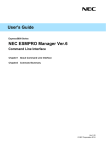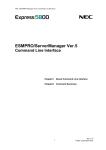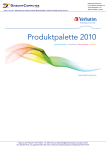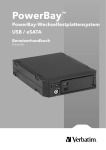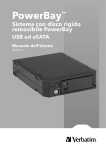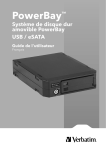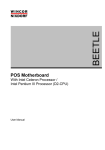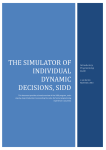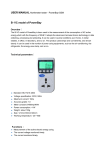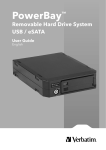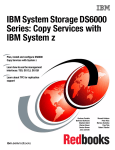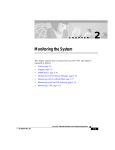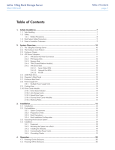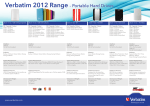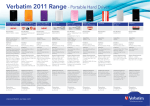Download NEC Express5800/R110d-1E User's Manual
Transcript
Front Cover NEC Command Line Interface Document Rev.1.08 NEC ESMPRO Manager Ver.5 Command Line Interface Contents Front Cover ....................................................................................................................................................... 1 Contents............................................................................................................................................................. 2 Trademarks...................................................................................................................................................... 5 About This Document ....................................................................................................................................... 6 Chapter1 About Command Line Interface .................................................................................................... 7 1.1 System Requirements ........................................................................................................................ 7 1.2 How to Execute Commands .............................................................................................................. 8 1.2.1 Notes on Entering Commands ............................................................................................... 8 1.3 Execution Results .............................................................................................................................. 9 1.4 Example............................................................................................................................................. 9 1.5 Executing Command from Two or More Manager Server ................................................................ 9 Chapter2 Command Summary .................................................................................................................... 10 2.1 Group management Commands ...................................................................................................... 10 2.1.1 getList .................................................................................................................................. 10 2.1.2 createGroup ......................................................................................................................... 12 2.1.3 deleteGroup ......................................................................................................................... 12 2.1.4 moveGroup .......................................................................................................................... 12 2.1.5 setGroupProperty................................................................................................................. 13 2.1.6 getGroupProperty ................................................................................................................ 13 2.1.7 getGroupStatus .................................................................................................................... 14 2.1.8 groupPowerOn..................................................................................................................... 14 2.1.9 groupPowerOff .................................................................................................................... 15 2.1.10 groupReset........................................................................................................................... 16 2.1.11 groupPowerCycle ................................................................................................................ 17 2.1.12 groupShutdownOs ............................................................................................................... 18 2.1.13 groupSetPowerRestoreDelay............................................................................................... 19 2.1.14 getGroupRemoteKvmLicense ............................................................................................. 20 2.2 Component Management Commands.............................................................................................. 21 2.2.1 getServerList........................................................................................................................ 21 2.2.2 getServerNameByMacAddr ................................................................................................ 22 2.2.3 getServerNameByGuid........................................................................................................ 22 2.2.4 findNewServer..................................................................................................................... 23 2.2.5 findNewServerNetAddr....................................................................................................... 24 2.2.6 createServer ......................................................................................................................... 24 2.2.7 deleteServer ......................................................................................................................... 25 2.2.8 checkConnection ................................................................................................................. 25 2.2.9 setServerProperty................................................................................................................. 26 2.2.10 moveServer.......................................................................................................................... 27 2.2.11 getServerGroup.................................................................................................................... 28 2.2.12 setCurrentPort...................................................................................................................... 28 2.2.13 getServerProperty ................................................................................................................ 28 2.2.14 getServerInfo ....................................................................................................................... 29 2.2.15 getDeviceId.......................................................................................................................... 31 2.2.16 getGuid ................................................................................................................................ 31 2.2.17 getProductName .................................................................................................................. 31 2.2.18 getSoftwareInfo ................................................................................................................... 32 2.2.19 setShutdownPolicy .............................................................................................................. 32 2.2.20 getShutdownPolicy.............................................................................................................. 34 2.2.21 setPowerRestoreDelay......................................................................................................... 34 2.2.22 getPowerRestoreDelay ........................................................................................................ 35 2.2.23 setBmcInfo .......................................................................................................................... 35 2.2.24 getBmcInfo .......................................................................................................................... 42 2 NEC ESMPRO Manager Ver.5 Command Line Interface 2.3 2.4 2.5 2.6 2.7 2.2.25 setAuthKey .......................................................................................................................... 44 2.2.26 setSensorLevel..................................................................................................................... 44 2.2.27 getSensorLevel .................................................................................................................... 46 2.2.28 getAgentExtensionLog ........................................................................................................ 48 2.2.29 testAlert ............................................................................................................................... 48 2.2.30 getTestAlertStatus................................................................................................................ 49 2.2.31 getServerStatus .................................................................................................................... 49 2.2.32 getPowerStatus .................................................................................................................... 50 2.2.33 getStatusLamp ..................................................................................................................... 50 2.2.34 getPanelInfo......................................................................................................................... 51 2.2.35 powerOn .............................................................................................................................. 52 2.2.36 powerOff.............................................................................................................................. 52 2.2.37 reset ..................................................................................................................................... 53 2.2.38 powerCycle.......................................................................................................................... 54 2.2.39 shutdownOs ......................................................................................................................... 55 2.2.40 dumpSwitch......................................................................................................................... 55 2.2.41 clearSel ................................................................................................................................ 56 2.2.42 identifyChassis .................................................................................................................... 56 2.2.43 getIpmiInfo .......................................................................................................................... 56 2.2.44 getSensorList ....................................................................................................................... 57 2.2.45 getSensorStatus.................................................................................................................... 57 2.2.46 getConsoleLog..................................................................................................................... 58 2.2.47 setBmcIpSync...................................................................................................................... 59 2.2.48 getBmcIpSync ..................................................................................................................... 59 2.2.49 getBladeSlotId ..................................................................................................................... 60 2.2.50 setBmcIpAddressLan1......................................................................................................... 60 2.2.51 setBmcIpAddressLan2......................................................................................................... 61 EM Card Management Commands ................................................................................................. 62 2.3.1 getEmCardList..................................................................................................................... 62 2.3.2 getEmActiveState ................................................................................................................ 63 2.3.3 identifyEm ........................................................................................................................... 63 2.3.4 getEmStatusLamp................................................................................................................ 64 Chassis Management Commands .................................................................................................... 65 2.4.1 getBladeEnclosureList......................................................................................................... 65 2.4.2 getChassisSlotState.............................................................................................................. 65 2.4.3 getChassisInfo ..................................................................................................................... 66 2.4.4 setChassisProperty............................................................................................................... 67 2.4.5 getChassisProperty .............................................................................................................. 67 2.4.6 setBladeAutoSetting ............................................................................................................ 68 2.4.7 getBladeAutoSetting............................................................................................................ 69 Communication Management Commands....................................................................................... 70 2.5.1 connect................................................................................................................................. 70 2.5.2 disconnect ............................................................................................................................ 70 2.5.3 getConnectionStatus ............................................................................................................ 70 Environment Setting Commands..................................................................................................... 71 2.6.1 setOption.............................................................................................................................. 71 2.6.2 getOption ............................................................................................................................. 72 2.6.3 getPermitIpAddrList............................................................................................................ 72 2.6.4 isPermitIpAddr .................................................................................................................... 73 2.6.5 addPermitIpAddr ................................................................................................................. 73 2.6.6 removePermitIpAddr ........................................................................................................... 73 2.6.7 clearPermitIpAddr ............................................................................................................... 74 User Management Commands......................................................................................................... 75 2.7.1 createUser ............................................................................................................................ 75 2.7.2 deleteUser ............................................................................................................................ 75 3 NEC ESMPRO Manager Ver.5 Command Line Interface getUserList .......................................................................................................................... 75 2.7.3 2.7.4 setUserProperty ................................................................................................................... 76 2.7.5 getUserProperty ................................................................................................................... 77 2.8 Other Commands............................................................................................................................. 78 2.8.1 getApplicationLog ............................................................................................................... 78 2.8.2 about .................................................................................................................................... 78 2.8.3 help ...................................................................................................................................... 78 4 NEC ESMPRO Manager Ver.5 Command Line Interface Trademarks NEC EXPRESSBUILDER and NEC ESMPRO are registered trademarks of NEC Corporation. Microsoft, Windows, Windows Vista, Windows Server are registered trademarks or trademarks of Microsoft Corporation in the United States and other countries. NetWare is a registered trademark of Novell, Inc. of the United States. All other company, or product names used in this document are registered trademarks or trademarks of their respective trademark owners. Windows 7 stands for Windows® 7 Professional operating system, Windows® 7 Ultimate operating system. Windows Server 2008 stands for Windows Server® 2008 Standard operating system, Windows Server® 2008 Enterprise operating system, Windows Server® 2008 Datacenter operating system, and Windows Server® 2008 Foundation. Windows Vista stands for Windows Vista® Business operating system, Windows Vista® Enterprise operating system, and Windows Vista® Ultimate operating system. Windows Server 2003 stands for Windows Server® 2003, Standard Edition operating system, Windows Server® 2003, Enterprise Edition operating system, Windows Server® 2003, Standard x64 Edition operating system, and Windows Server® 2003, Enterprise x64 Edition operating system. Windows Server 2003 R2 stands for Windows Server® 2003 R2, Standard Edition operating system, Windows Server® 2003 R2, Enterprise Edition operating system, Windows Server® 2003 R2, Standard x64 Edition operating system, and Windows Server® 2003 R2, Enterprise x64 Edition operating system. Windows XP stands for Windows® XP Professional operating system, and Windows® XP Professional x64 Edition operating system. Windows 2000 stands for Windows® 2000 Professional operating system, Windows® 2000 Server operating system, and Windows® 2000 Advanced Server operating system. All names used in sample applications are fictitious. They are unrelated to existing product, organization, or individual names. Notes (1) No part of this document may be reproduced in any form without the prior written permission of NEC Corporation. (2) The contents of this document may be revised without prior notice. (3) The contents of this document shall not be copied or altered without the prior written permission of NEC Corporation (4) All efforts have been made to ensure the accuracy of all information in this document. If you notice any part unclear, incorrect, or omitted in the document, contact your authorized NEC sales representative. (5) NEC assumes no liability for damages arising from the use of this product, nor any liability for incidental or consequential damages arising from the use of this document regardless of (4) 5 NEC ESMPRO Manager Ver.5 Command Line Interface About This Document This document introduces command line interface of the component management utility "NEC ESMPRO Manager". Before attempting to operate the command line interface, read this document so as to gain an adequate understanding of the contents. Attention This document is intended for persons who are familiar with the operating system's functions and operations and the network's functions and setup. For operations and inquiries about the operating system, see its online help information. This document covers universal information about generally managed components. The notes and restrictions on use of each product as a managed component are explained in the user's guide provided with the managed component. Names used with screen images in this document are fictitious. They are unrelated to existing product names, names of organizations, or individual names. The setting values on the screen images are shown as examples, so setting values such as IP addresses on screen images are not guaranteed for operation. About Symbols in This Document The following explains three symbols that are used in this document: IMPORTANT: CHECK: TIP: Points that are mandatory or require attention when using the software or the component. Points that are require confirmation when using the software or the component. Helpful and convenient piece of information. About Font in This Document The Italic font shows the option of command in this document. For other information about the NEC ESMPRO Manager See the documents below. NEC ESMPRO Manager Ver.5 Installation Guide NEC ESMPRO Manager Ver.5 Setup Guide NEC ESMPRO Manager Ver.5 Command Line Interface User's Guide for NEC ExpressUpdate 6 NEC ESMPRO Manager Ver.5 Command Line Interface Chapter1 About Command Line Interface The NEC ESMPRO Manager command line interface provides a set of commands that can control managed components through the command line from the management PC. The set of commands covers a part of functions that can be executed by using the web browser. CHECK: The set of commands mainly enables to execute functions by communication with BMC or NEC ESMPRO Agent Extension on the managed component. It does not support the functions that require NEC ESMPRO Agent on the managed component. The following commands are available: 1.1 Group management Commands Use to operate a group due to operate more than one managed components through a single operation. Component Management Commands Use to operate a managed component. EM Card Management Commands Use to operate an EM card. Chassis Management Commands Use to operate a chassis. Communication Management Commands Use to change settings for connection to a managed component via modem or directly. Environment Setting Commands Use to view and change the settings of NEC ESMPRO Manager. User Management Commands Use to manage users who operate NEC ESMPRO Manager on web browser. Other Commands System Requirements The NEC ESMPRO Manager command line interface can be executed only on a PC (called a Manager server) that is installed the NEC ESMPRO Manager. The NEC ESMPRO Manager command line interface requires following user level of operating system: On Windows: Administrator On Linux: root CHECK: In case of Windows Vista, Windows 7 and Windows Server 2008, you need to set the permission to access to the directory including Command Line Interface execution file (dscli.exe). After setting the permission to access the directory, the standard user can also use Command Line Interface. TIP: See “NEC ESMPRO Manager Ver.5 Installation Guide” about the system requirement of NEC ESMPRO Manager. 7 NEC ESMPRO Manager Ver.5 Command Line Interface 1.2 How to Execute Commands To execute a command, enter the command following the command prompt as shown below. dscli CommandName [Option, …] dscli : CommandName : Option : Indicates the NEC ESMPRO Manager command line interface command Enter the name of the command you want to execute. Enter the option parameters defined for each command 1.2.1 Notes on Entering Commands This section explains notes on entering commands (1) When entering special characters: If you input null string or special characters as option, enclose the option parameter between double quotation marks. The following shows examples: Example1: Input null string dscli setGroupProperty MyGroup GROUP_COMMENT “” Example 2: Input special characters dscli setServerProperty MyServer CFG_SERIAL_INIT “ATE1Q0V1X4&D2&C1S0=0” (2) When entering MAC address: MAC address that can be specified in “Component” of command option is the MAC address of LAN that BMC uses on the managed component. Input MAC address as hexadecimal number that is delimited to octets by a colon. The following shows an example: dscli getServerProperty 00:30:13:16:cd:fe SERVER_IP_1 (3) When entering GUID: Input GUID as hexadecimal number that is delimited to sections by a colon. The following shows an example: dscli getServerProperty 80c03228:35d8:d711:8001:003013f10072 SERVER_IP_1 CHECK: You can enter the command format that MAC address or GUID is specified as Server option after the “Check Connection” is performed for the server. 8 NEC ESMPRO Manager Ver.5 Command Line Interface 1.3 Execution Results All the commands return the end status. If an error has occurred, they return an error message. The end status of all the commands is as follows: 0 Non Zero value Normal end Error end If a command error occurs, a non-zero value will be returned as the end status and the error message will be displayed. Some error messages are displayed followed by an error cause message TIP: If a command is executed with a shell script, the end status can be confirmed with "ERRORLEVEL" for Windows and "$?" for Linux. 1.4 Example The procedure to manage a component via LAN is as follows: (1) Creates a new component group using createGroup command. (2) Register a managed component using createServer command. (3) Perform a "Check Connection" for the managed component using checkConnection command. You can manage the managed component after "Check Connection" is completed. 1.5 Executing Command from Two or More Manager Server As well as one component can be managed from two or more manager server, you can also execute command from two or more manager server. IMPORTANT: See “NEC ESMPRO Manager Ver.5 Installation Guide” about Notes. 9 NEC ESMPRO Manager Ver.5 Command Line Interface Chapter2 Command Summary 2.1 Group management Commands 2.1.1 getList Syntax: dscli getList GroupName [/g] [/x] Description: Displays the list of groups and components registered under the specified group. If no appending option is specified, displays the groups and components just under the specified group. Options: GroupName Specify the name of the group. If you want to display the groups and components under root, specify “root”. /g Display only groups. /x Display the list under the specified group or its sub-groups. Output: Shows the example that the groups and components have following structure. root group1 <GROUP> group11 <GROUP> component111 component11 group2 <GROUP> component1 group3 <GROUP> group31 <GROUP> component311 component31 component32 group32 <GROUP> component321 component322 component2 component3 10 NEC ESMPRO Manager Ver.5 Command Line Interface Displays the list of groups and components. The following shows an example. >dscli getList root group1 <GROUP> group2 <GROUP> component1 group3 <GROUP> component2 component3 Displays the case specified “/g” option. The following shows an example. >dscli getList root /g group1 <GROUP> group2 <GROUP> group3 <GROUP> Displays the case specified “/x” option. The following shows an example. >dscli getList root /x root group1 <GROUP> group11 <GROUP> component111 component11 group2 <GROUP> component1 group3 <GROUP> group31 <GROUP> component311 component31 component32 group32 <GROUP> component321 component322 component2 component3 Displays the case specified “/g” and “/x” option. The following shows an example. >dscli getList root /g /x root group1 <GROUP> group11 <GROUP> group2 <GROUP> group3 <GROUP> group31 <GROUP> group32 <GROUP> 11 NEC ESMPRO Manager Ver.5 Command Line Interface 2.1.2 createGroup Syntax: dscli createGroup GroupName [ParentGroupName] Description: Creates a new component group. Options: GroupName Specify the group name to create. You can input up to 63 characters. ParentGroupName Specify the name of the parent group when the group is made under the group. If you create a group under root, specify “root” or omit this option. TIP: The name of group that is already registered cannot be specified to GroupName 2.1.3 deleteGroup Syntax: dscli deleteGroup GroupName Description: Deletes a specified group. All managed components and sub-groups in the group are also deleted. Options: GroupName Specify the name of the group. 2.1.4 moveGroup Syntax: dscli moveGroup GroupName [ParentGroupName] Description: Move the specified group. All managed components and sub-groups in the group are also moved Options: GroupName Specify the name of group. ParentGroupName Specify the name of the parent group to move to. If you move the group under root, specify “root” or omit this option. 12 NEC ESMPRO Manager Ver.5 Command Line Interface 2.1.5 setGroupProperty Syntax: dscli setGroupProperty GroupName PropertyName Value Description: Sets the property of a group. Options: GroupName Specify the name of group. PropertyName Specify the name of the group property. PropertyName GROUP_NAME GROUP_COMMENT The following is group property list: Contents Specify the name of the group. Enter the comments of the group. Value Up to characters. Up to characters. 63 Default (None) 255 (Blank) Value Specify a new value to be set. TIP: The name of group that is already registered cannot be specified to GROUP_NAME. 2.1.6 getGroupProperty Syntax: dscli getGroupProperty GroupName PropertyName Description: Displays the property of a group. Options: GroupName Specify the name of group. PropertyName Specify the name of group property. For the list of group properties, see the 2.1.5 setGroupProperty command Output: Display the property of a group. 13 NEC ESMPRO Manager Ver.5 Command Line Interface 2.1.7 getGroupStatus Syntax: dscli getGroupStatus GroupName Description: Displays the status of a specified component group. Among all component condition under the group, displays the worst condition as a status of the group. Confirms the condition of component by component monitoring function. Options: GroupName Specify the name of group. Output: Displays the status of the specified component group. There are following types of status. ERROR WARNING UNKNOWN DC-OFF NORMAL NO_MONITORING Error Warning Unknown or connection error DC-OFF Normal Out of monitoring 2.1.8 groupPowerOn Syntax: dscli groupPowerOn GroupName [/p] [/exs ComponentName1 ComponentName2 ... ComponentNameN] [/exg GroupName1 GroupName2 ... GroupNameN] Description: Turns on all managed components in a specified group. The managed components in the sub-group are also controlled. IMPORTANT: In case that the managed component does not support a force network-boot function which boots the component from network regardless of boot order, a force network-boot function cannot be executed. See “NEC ESMPRO Manager Managed Components Summary” whether the managed component supports function. CHECK: This command is not executed for the PowerBay, the EM card, and the switch blade. Options: GroupName Specify the name of group. If you want to control all the components under root, specify “root”. /p Force boot from network after the power is turned on. 14 NEC ESMPRO Manager Ver.5 Command Line Interface TIPS: See 2.2.9 setServerProperty for server properties. /exs When you specify “/exs” option and the component name after it, the command is not executed on the specified component. You can specify plural component names. /exg When you specify “/exg” option and the group name after it, the command is not executed on the component under the specified group. You can specify plural group names. Output: If error has occurred, the name and the error message about each error-occurred managed component is displayed. The following shows an example. Component1 : Connection to the server could not be made. (Timeout) Component2 : Connection to the server could not be made. (Authentication error) 2.1.9 groupPowerOff Syntax: dscli groupPowerOff GroupName [/exs ComponentName1 ComponentName2 ComponentNameN] [/exg GroupName1 GroupName2 ... GroupNameN] ... Description: Forcibly turns off all managed components in a specified group. The managed components in the sub-group are also controlled. IMPORTANT: Since remote power control using NEC ESMPRO Manager is provided by hardware regardless of the condition of operating system on the managed component, the system may be damaged. Be careful when you perform remote power control. Reconfirm the status of the managed component before power controls. CHECK: This command is not executed for the PowerBay, the EM card, and the switch blade. Options: GroupName Specify the name of group. If you want to control all the components under root, specify “root”. /exs When you specify “/exs” option and the component name after it, the command is not executed on the specified component. You can specify plural component names. /exg When you specify “/exg” option and the group name after it, the command is not executed on the component under the specified group. You can specify plural group names. 15 NEC ESMPRO Manager Ver.5 Command Line Interface Output: If error has occurred, the name and the error message about each error-occurred managed component is displayed. The following shows an example. Component1 : Connection to the server could not be made. (Timeout) Component2 : Connection to the server could not be made. (Authentication error) 2.1.10 groupReset Syntax: dscli groupReset GroupName [/p] [/exs ComponentName1 ComponentName2 ... ComponentNameN] [/exg GroupName1 GroupName2 ... GroupNameN] Description: Forcibly resets all managed components in a specified group. The managed components in the sub-group are also controlled. IMPORTANT: Since remote power control using NEC ESMPRO Manager is provided by hardware regardless of the condition of operating system on the managed component, the system may be damaged. Be careful when you perform remote power control. Reconfirm the status of the managed component before power controls. In case that the managed component does not support a force network-boot function which boots the component from network regardless of boot order, a force network-boot function cannot be executed. See “NEC ESMPRO Manager Managed Components Summary” whether the managed component supports function. CHECK: This command is not executed for the PowerBay, the EM card, and the switch blade. Options: GroupName Specify the name of group. If you want to control all the components under root, specify “root”. /p Force boot from network after reset. TIP: See 2.2.9 setServerProperty for server properties. /exs When you specify “/exs” option and the component name after it, the command is not executed on the specified component. You can specify plural component names. /exg When you specify “/exg” option and the group name after it, the command is not executed on the component under the specified group. You can specify plural group names. 16 NEC ESMPRO Manager Ver.5 Command Line Interface Output: If error has occurred, the name and the error message about each error-occurred managed component is displayed. The following shows an example. Component1 : Connection to the server could not be made. (Timeout) Component2 : Connection to the server could not be made. (Authentication error) 2.1.11 groupPowerCycle Syntax: dscli groupPowerCycle GroupName [/p] [/exs ComponentName1 ComponentName2 ... ComponentNameN] [/exg GroupName1 GroupName2 ... GroupNameN] Description: Forcibly turns off all managed components in a specified group and then turns them on. The managed components in the sub-group are also controlled. IMPORTANT: Since remote power control using NEC ESMPRO Manager is provided by hardware regardless of the condition of operating system on the managed component, the system may be damaged. Be careful when you perform remote power control. Reconfirm the status of the managed component before power controls. In case that the managed component does not support a force network-boot function which boots the component from network regardless of boot order, a force network-boot function cannot be executed. See “NEC ESMPRO Manager Managed Components Summary” whether the managed component supports function. CHECK: This command is not executed for the PowerBay, the EM card, and the switch blade. Options: GroupName Specify the name of group. If you want to control all the components under root, specify “root”. /p Force boot from network after the power is turned on. /exs When you specify “/exs” option and the component name after it, the command is not executed on the specified component. You can specify plural component names. /exg When you specify “/exg” option and the group name after it, the command is not executed on the component under the specified group. You can specify plural group names. TIP: See 2.2.9 setServerProperty for server properties. 17 NEC ESMPRO Manager Ver.5 Command Line Interface Output: If error has occurred, the name and the error message about each error-occurred managed component is displayed. The following shows an example. Component1 : Connection to the server could not be made. (Timeout) Component2 : Connection to the server could not be made. (Authentication error) 2.1.12 groupShutdownOs Syntax: dscli groupShutdownOs GroupName [/force] [/exs ComponentName1 ComponentName2 ... ComponentNameN] [/exg GroupName1 GroupName2 ... GroupNameN] Description: Shut downs operating systems on all managed components in a specified group. The managed components in the sub-group are also controlled. This command via LAN instructs the NEC ESMPRO Agent Extension service to shutdown the operating system. If you specify “/force” option, this command executes the forced shutdown OS function without communication to the NEC ESMPRO Agent Extension or the NEC ESMPRO Agent. You need to specify “/force” option if the connection is via LAN or direct. CHECK: This command is not executed for the PowerBay, the EM card, and the switch blade. Options: GroupName Specify the name of group. If you want to control all the components under root, specify “root”. /force If you specify “/force” option, this command executes the forced shutdown OS function. This shutdown may not work depending on the kind of OS or the OS settings. /exs When you specify “/exs” option and the component name after it, the command is not executed on the specified component. You can specify plural component names. /exg When you specify “/exg” option and the group name after it, the command is not executed on the component under the specified group. You can specify plural group names. Output: If error has occurred, the name and the error message about each error-occurred managed component is displayed. The following shows an example. Component1 : Connection to the component could not be made. (Timeout) Component2 : Connection to the component could not be made. (Authentication error) 18 NEC ESMPRO Manager Ver.5 Command Line Interface 2.1.13 groupSetPowerRestoreDelay Syntax: dscli groupSetPowerRestoreDelay GroupName DelayTime [/x Policy] [/exs ComponentName1 ComponentName2 ... ComponentNameN] [/exg GroupName1 GroupName2 ... GroupNameN] Description: Changes the power option that specifies working of managed components in a specified group when they are turned AC ON. The managed components in the sub-group are also controlled. The power option includes AC-LINK policy and the time that delays Power ON (DC ON) when the managed component is set to be turned DC ON in time with AC ON. IMPORTANT: In case that the managed component does not support a setting of power restore delay, this command is invalid. See “NEC ESMPRO Manager Managed Components Summary” whether the managed component supports the function. CHECK: This command is not executed for the PowerBay, the EM card, and the switch blade. Options: GroupName Specify the name of group. If you want to control all the components under root, specify “root”. DelayTime Specify delay time in the range 0-600 seconds. When -1 is specified, the delay time is not changed. /x Policy Sets AC-Link Policy. STAY_OFF LAST_STATE POWER_ON No change is made if omitted There are 3 types of the policy. The managed component remains OFF when AC power is restored. If the managed component is OFF when AC power is lost, the managed component remains OFF when AC power is restored. If the managed component is ON, when AC power is lost, the managed component turns ON after the delay time when AC power is restored. The managed component turns ON after the delay time when AC power is restored. /exs When you specify “/exs” option and the component name after it, the command is not executed on the specified component. You can specify plural component names. /exg When you specify “/exg” option and the group name after it, the command is not executed on the component under the specified group. You can specify plural group names. Output: If error has occurred, the name and the error message about each error-occurred managed component is displayed. The following shows an example. Component1 19 NEC ESMPRO Manager Ver.5 Command Line Interface : Connection to the component could not be made. (Timeout) Component2 : Connection to the component could not be made. (Authentication error) 2.1.14 getGroupRemoteKvmLicense Syntax: dscli getGroupRemoteKvmLicense GroupName Description: Displays the state of “Remote KVM and Media License” for each managed components in a specified group. The managed components in the sub-group are also displayed. Options: GroupName Specify the name of group. If you want to control all the components under root, specify “root”. Output: The following are states of “Remote KVM and Media License”. Installed Not Installed Unsupported - “Remote KVM and Media License” has been installed. “Remote KVM and Media License” has not been installed. “Remote KVM and Media License” is not supported for the component. The state of “Remote KVM and Media License” is unknown. The following shows an example. Component1 : Installed Component2 : Installed Component3 : Not Installed Component4 : Unsupported Component5 : : : 20 NEC ESMPRO Manager Ver.5 Command Line Interface 2.2 Component Management Commands 2.2.1 getServerList Syntax: dscli getServerList [/d] Description: Displays the name list of all managed components registered on NEC ESMPRO Manager. Options: /d If you specify “/d” option, the managed components list will indicate component name, GUID and MAC address of LAN port that BMC uses of each component. Added information below is also indicated. EXPRESSSCOPE Engine series BMC is EXPRESSSCOPE Engine series. ARMC : BMC is Advanced Remote Management Card. SWB : indicates that the managed component is a kind of switch blade. Output: Displays the name list of all managed components registered on NEC ESMPRO Manager. The following shows an example. If “/d” option is not specified: Component1 Component2 Component3 : : If “/d” option is specified: Component1 GUID 02010202:0000:0000:0000:000000000000 MAC1 00:30:13:f1:00:5a MAC2 00:30:13:f1:00:5b EXPRESSSCOPE Engine Component2 GUID 00301316:cdfe:0180:0010:846e8062d906 MAC1 00:30:13:16:cd:fe SWB Component3 GUID 00010203:0405:0607:0809:0a0b0c0d0e0f MAC1 00:00:4c:9f:13:cb ARMC : : 21 NEC ESMPRO Manager Ver.5 Command Line Interface 2.2.2 getServerNameByMacAddr Syntax: dscli getServerNameByMacAddr MacAddress Description: Displays the name of the managed component that has the specified MAC address. Options: MacAddress Specify a MAC address of LAN port that BMC uses on the managed component. The following shows an example. dscli getServerNameByMacAddr 00:30:13:f1:00:5a Output: Displays the name of the managed component. The following shows an example. Component1 2.2.3 getServerNameByGuid Syntax: dscli getServerNameByGuid GUID Description: Displays the name of the managed component that has the specified GUID. Options: GUID Specify a GUID. The following shows an example. dscli getServerNameByGuid 00301316:cdfe:0180:0010:846e8062d906 Output: Displays the name of the managed component. The following shows an example. Component2 22 NEC ESMPRO Manager Ver.5 Command Line Interface 2.2.4 findNewServer Syntax: dscli findNewServer StartIpAddr EndIpAddr Description: Finds BMC on managed components that are not registered on NEC ESMPRO Manager according to IP address range specification. TIP: To register the managed component that is found using findNewServer command or findNewServerNetAddr command, you can use createServer command. See 2.2.6 createServer. Options: StartIpAddr Specify the start address of IP address range. EndIpAddr Specify the end address of IP address range. Output: Displays the list of the found managed components. The following shows an example. Status: SUCCESS No.1 1st IP Address 2nd IP Address Current IP Address IPMI Version GUID No.2 1st IP Address 2nd IP Address Current IP Address IPMI Version GUID : : : : : : : 192.168.14.18 0.0.0.0 192.168.14.18 1.5 84ee20b0:84a1:d511:0080:a0ff94470300 : : : : : 192.168.14.19 0.0.0.0 192.168.14.19 1.5 00004c79:45c0:0180:0010:f57f80d8cef8 23 NEC ESMPRO Manager Ver.5 Command Line Interface 2.2.5 findNewServerNetAddr Syntax: dscli findNewServerNetAddr NetAddr NetMask Description: Finds BMC on managed components that are not registered on NEC ESMPRO Manager according to Network address specification. TIP: To register the managed component that is found using findNewComponent command or findNewServerNetAddr command, you can use createServer command. See 2.2.6 createServer. Options: NetAddr Specify network address. NetMask Specify network mask. Output: Displays the list of the found managed components same as the output by “findNewServer” command. 2.2.4 findNewServer. See 2.2.6 createServer Syntax: dscli createServer ComponentName GroupName AuthKey [IpAddr1] [IpAddr2] Description: Newly registers a managed component on the NEC ESMPRO Manager. Options: ComponentName Specify the name of the managed component. You can input up to 63 characters. GroupName Specify the name of group that the managed component belongs to. AuthKey Specify the authentication key that is configured on BMC. You can input up to 16 characters. IpAddr1 Specify the IP address of the managed component's BMC. This option is omissible if you control the managed component via modem or with direct connection. IpAddr2 Specify the extra IP address of the managed component's BMC. This option is omissible. TIPS: The name of component that is already registered cannot be specified to ComponentName. The IP address that is already registered cannot be specified to IpAddr1and IpAddr2. Set other properties using 2.2.9 setServerProperty command. 24 NEC ESMPRO Manager Ver.5 Command Line Interface 2.2.7 deleteServer Syntax: dscli deleteServer Component [/force] Description: Deletes the specified managed component that is registered on the NEC ESMPRO Manager. Options: Component Specify the name, the MAC address of LAN port that BMC uses, or the GUID of the managed component. /force When you delete the managed component that has been set schedule running, the schedule is deleted from NEC ESMPRO Agent Extension. But if the schedule deletion is failed (such as NEC ESMPRO Agent Extension is uninstalled), the component cannot be deleted. In this case you can specify “/force” option to delete component forcibly. 2.2.8 checkConnection Syntax: dscli checkConnection Component [/force] Description: Confirms connection with BMC on a managed component. This command also collects information for remote control of the managed component. Options: Component Specify the name, the MAC address of LAN port that BMC uses, or the GUID of the managed component.. /force Execute the command with "/force" option if the managed component is replaced. TIP: If NEC ESMPRO Manager Ver.5 manage NEC ESMPRO Manager Ver.4, and the “/force” option is specified, NEC ESMPRO Manager Ver.5 may connect with different component in communication with NEC ESMPRO Manager Ver.4 and BMC communication. 25 NEC ESMPRO Manager Ver.5 Command Line Interface 2.2.9 setServerProperty Syntax: dscli setComponentProperty Component PropertyName Value Description: Sets the property of a managed component. Options: Component Specify the name, the MAC address of LAN port that BMC uses, or the GUID of the managed component. PropertyName Specify the name of the property. PropertyName CONSOLE_LOG_ENABLE CONSOLE_LOG_SIZE CONSOLE_LOG_KEEP_CONN ECTION CONSOLE_LOG_FAULT_MESS AGE_MONITORING CONSOLE_LOG_FAULT_MESS AGE_IDENTIFIER SERVER_NAME *1 SERVER_AUTHKEY *1 SERVER_CURRENT_PORT_T YPE SERVER_IP_1 *1 SERVER_IP_2 SERVER_CURRENT_IP *1 SERVER_SUBNETMASK_1 *1 The following is property list: Contents Determine whether to enable/disable the get console log function to save the Remote Console screen data in text format. Specify the maximum size (in KB) of the console log. Determine whether to get console log even while remote console is not open on web browser. Determine whether to enable/disable the fault message monitoring function that set fault condition when a fault message string is found on head of each console log line. Specify the character string for the fault message monitoring function. Specify the name of the managed component. Specify the authentication key to communicate with BMC of the managed component. Specify the connection type between the NEC ESMPRO Manager component and the managed component. Only LAN can be specified for the EM card. Specify BMC IP address to communicate via LAN. Specify extra BMC IP address to communicate via LAN. Specify current BMC IP address to communicate via LAN. Specify subnet mask of the BMC IP address. 26 Value 0: Disabled 1: Enabled Default 1 4 - 1000 64 0: Disabled 1: Enabled 0 0: Disabled 1: Enabled 1 Up to 20 characters Up to 63 characters. Up to 16 characters </BP> 0: LAN 1: Direct 2: Modem 0 IP format IP format IP format IP format address 0.0.0.0 address 0.0.0.0 address 0.0.0.0 address 255.255 .255.0 (None) (None) NEC ESMPRO Manager Ver.5 Command Line Interface PropertyName SERVER_SUBNETMASK_2 SERVER_PHONE_NUMBER Contents Specify subnet mask of the extra BMC IP address. Specify the phone number to communicate via modem. Value IP address format Up to 19 characters Default 255.255 .255.0 (Blank) Specify the alias of the managed component. Up to 255 bytes (Same as compon ent name) SERVER_ALIAS *1 *1 The property can be also set for an EM card. Value Specify new value to be set. TIPS: The name of component that is already registered cannot be specified to SERVER_NAME. The IP address that is already registered cannot be specified to SERVER_IP_1 and SERVER_IP_2. You can use moveServer command to change group that the managed component belongs to. See 2.2.10. 2.2.10 moveServer Syntax: dscli moveServer Component GroupName Description: Changes the group that a managed component belongs to. Options: Component Specify the name, the MAC address of LAN port that BMC uses, or the GUID of the managed component. GroupName Specify the name of new group. If you want to move the component under root, specify “root”. 27 NEC ESMPRO Manager Ver.5 Command Line Interface 2.2.11 getServerGroup Syntax: dscli getServerGroup Component Description: Display the name of group that a managed component belongs to. Options: Component Specify the name, the MAC address of LAN port that BMC uses, or the GUID of the managed component. Output: Display the name of group that the managed component belongs to. If it belongs to root, displays “root”. 2.2.12 setCurrentPort Syntax: dscli setCurrentPort Component Connection Description: Changes the connection type between the NEC ESMPRO Manager component and a managed component. Options: Component Specify the name, the MAC address of LAN port that BMC uses, or the GUID of the managed component. Connection Specify the connection type between the NEC ESMPRO Manager component and the managed component. LAN SERIAL MODEM Connects via LAN Connects directly to serial port Connects via modem 2.2.13 getServerProperty Syntax: dscli getServerProperty Component PropertyName Description: Displays the specified property of a managed component. Options: Component Specify the name, the MAC address of LAN port that BMC uses, or the GUID of the managed component.. PropertyName Specify the name of component property. For the list of component properties, see the 2.2.9 28 NEC ESMPRO Manager Ver.5 Command Line Interface setServerProperty command. Output: Displays the specified property of a managed component. 2.2.14 getServerInfo Syntax: dscli getComponentInfo Component Description: Displays the managed component information that includes main component properties. Options: Component Specify the name, the MAC address of LAN port that BMC uses, or the GUID of the managed component. Output: Displays the managed component information. The following information is shown: Item Name Component Name Alias Group Connection Type BMC Control Check Connection BMC Current IP Address Failover BMC LAN1 IP Address BMC LAN1 Subnet Mask BMC LAN2 IP Address BMC LAN2 Subnet Mask Phone Number Product Name Serial Number GUID IPMI Version Remote KVM and Media License Chassis Name Slot Number Blade Width Contents Name of the managed component Alias of the managed component Name of the group that the managed component belongs to. Connection type between the managed component and the NEC ESMPRO Manager component. Display BMC management status Enable : management is valid Disable : managemant is invalid Not Registered : not registered for management Not Support : out of management (BMC is not integrated) Display “Completed” if the Check connection has been executed. Current BMC IP address to connect to the managed component via LAN. Determine whether to enable/disable the Fail over function that continues communication by changing to the other IP address if communication with the current BMC IP address encounters an error. BMC IP address to connect to the managed component via LAN. Subnet mask of the BMC IP address Extra BMC IP address to connect to the managed component via LAN. Subnet mask of the extra BMC IP address Phone number of the managed component Product name of the managed component Serial number of the managed component ID for identifying the managed component IPMI version that the managed component supports State of "Remote KVM and Media License" of the managed component. If this managed component does not contain EXPRESSSCOPE Engine series, this item is not shown. See 2.1.14”getGroupRemoteKvmLicense” for details. Name of chassis in which the managed component is installed. This item is shown If the managed component is CPU blade or switch blade. Slot number of the blade slot in which the managed component is installed. This item is shown If the managed component is CPU blade or switch blade. Blade width with the occupied slot count. This item is shown If the managed component is CPU blade or switch blade. 29 NEC ESMPRO Manager Ver.5 Command Line Interface Blade Height Blade Name Blade Height with the occupied slot count. This item is shown If the managed component is CPU blade or switch blade. Blade name. This item is shown if the managed component has the name. 30 NEC ESMPRO Manager Ver.5 Command Line Interface 2.2.15 getDeviceId Syntax: dscli getDeviceId Component Description: Obtains management controller information of the managed component. Options: Component Specify the name, the MAC address of LAN port that BMC uses, or the GUID of the managed component. Output: Displays management controller information. The following shows an example. Device ID : 20H Device Rev. : 1 Fw Rev. : 00.08 Manufacturer ID : 119 Product ID : 2c3H 2.2.16 getGuid Syntax: dscli getGuid Component Description: Obtains GUID of a managed component. GUID is ID for identifying a managed component. Options: Component Specify the name, the MAC address of LAN port that BMC uses, or the GUID of the managed component. Output: Displays GUID. 2.2.17 getProductName Syntax: dscli getProductName Component Description: Obtains the product name and serial number of a managed component. Options: Component Specify the name, the MAC address of LAN port that BMC uses, or the GUID of the managed component. Output: Displays the following information. 31 NEC ESMPRO Manager Ver.5 Command Line Interface ProductName SerialNumber product name of the managed component. serial number of the managed component. 2.2.18 getSoftwareInfo Syntax: dscli getSoftwareInfo Component Description: Obtains version information about NEC ESMPRO Agent Extension, operating system, BIOS and LAN driver on the managed component. This command can be used via LAN when NEC ESMPRO Agent Extension service is running on the managed component. Options: Component Specify the name, the MAC address of LAN port that BMC uses, or the GUID of the managed component. Output: Displays version information. The following shows an example. Agent Extension Version BIOS Version OS Version LAN driver Version : 2.03.04 : 6.0.0106 : Windows 2003 Server : 5.0.2175.1 2.2.19 setShutdownPolicy Syntax: dscli setShutdownPolicy Component KeyName Value Description: Changes shutdown policy of NEC ESMPRO Agent Extension on a managed component. This command can be used via LAN when NEC ESMPRO Agent Extension service is running on the managed component. Options: Component Specify the name, the MAC address of LAN port that BMC uses, or the GUID of the managed component. KeyName Specify a key name. See the list below.. Value Specify a new value. See the list below. KeyName Contents 32 Value NEC ESMPRO Manager Ver.5 Command Line Interface KeyName SCH_ACLINK_STAYON_ENABLE SCH_AC_LINK SCH_DC_OFF_ENABLE SCH_DC_OFF_DELAY SCH_SHUTDOWN_ENABLE SCH_SHUTDOWN_WAIT Contents Determine whether to enable/disable the function that changes AC-LINK policy to ”Always Power On” when “OS shutdown” is executed through “scheduled running” Specify AC-LINK Policy. (This setting works like as setPowerRestoreDelay command.) * Display only. Cannot be set. Determine whether to enable/disable the function that turns the managed component off forcibly after shutdown OS. If the managed component is still DC-ON state after OS shutdown, set enable to turn it off when NEC ESMPRO Agent Extension shutdowns its OS. Specify delay time in minutes to turn the managed component off after shutdown OS. This setting is effective only when SCH_DC_OFF_ENABLE is enabled. Determine whether to enable/disable the function which shutdowns OS when the managed component is turned on during the down period specified through “scheduled running”. Specify delay time in seconds to shutdown the managed component after shutdown OS command is issued. * Display only. Cannot be set. 33 Value 0: Disabled 1: Enabled - 0: Disabled 1: Enabled 5-60 0: Disabled 1: Enabled - NEC ESMPRO Manager Ver.5 Command Line Interface 2.2.20 getShutdownPolicy Syntax: dscli getShutdownPolicy Component Description: Obtains shutdown policy of NEC ESMPRO Agent Extension on a managed component. This command can be used via LAN when NEC ESMPRO Agent Extension service is running on the managed component. Options: Component Specify the name, the MAC address of LAN port that BMC uses, or the GUID of the managed component. Output: Displays shutdown policy. For details, see 2.2.19. The following shows an example. SCH_ACLINK_STAYON_ENABLE=0 SCH_AC_LINK=1 SCH_DC_OFF_ENABLE=1 SCH_DC_OFF_DELAY=10 SCH_SHUTDOWN_ENABLE=1 SCH_SHUTDOWN_WAIT=60 2.2.21 setPowerRestoreDelay Syntax: dscli setPowerRestoreDelay Component DelayTime [/x Policy] Description: Changes the power option that specifies working of a managed component when it is turned AC ON. The power option includes AC-LINK policy and the time that delays Power ON (DC ON) when the managed component is set to be turned DC ON in time with AC ON. IMPORTANT: In case that the managed component does not support a setting of power restore delay, This command is invalid. See “NEC ESMPRO Manager Managed Components Summary” whether the managed component supports the function. Options: Component Specify the name, the MAC address of LAN port that BMC uses, or the GUID of the managed component. DelayTime Specify delay time in the range 0-600 seconds. When -1 is specified, the delay time is not changed. /x Policy Sets AC-Link Policy. STAY_OFF No change is made if omitted There are 3 types of the policy. The managed component remains OFF when AC power is restored. 34 NEC ESMPRO Manager Ver.5 Command Line Interface LAST_STATE POWER_ON If the managed component is OFF when AC power is lost, the managed component remains OFF when AC power is restored. If the managed component is turned AC OFF during it is in DC ON, the managed component is turned DC ON after the delay time when it is turned AC ON. The managed component is turned DC ON after the delay time when it is turned AC ON. 2.2.22 getPowerRestoreDelay Syntax: dscli getPowerRestoreDelay Component Description: Obtains power option that specifies working of a managed component when it is turned AC ON. For details, see 2.2.21 setPowerRestoreDelay. Options: Component Specify the name, the MAC address of LAN port that BMC uses, or the GUID of the managed component. Output: Display power option information. The following shows an example. POLICY : LAST_STATE Power Restore Delay : 30 sec Power Restore Delay(default) : 0 sec 2.2.23 setBmcInfo Syntax: dscli setBmcInfo Component KeyName Value Description: Changes BMC configuration information on the managed component. The parameter supported according to the kind of BMC is different. TIP: Use setAuthKey command to change authentication key or password of PPP server. See 2.2.25 setAuthKey. Use setSensorLevel command to change separate sensor level. See 2.2.26 setSensorLevel. CFG_NETWORK_SHARED_BMC_LAN,CFG_NETWORK_BMC_MAC is not change. Use getBmcInfo command. See 2.2.24 getBmcInfo. Options: Component Specify the name, the MAC address of LAN port that BMC uses, or the GUID of the managed component. KeyName Specify the key name of BMC configuration. See the following list. Value Specify the new values to be set. See the following list. 35 NEC ESMPRO Manager Ver.5 Command Line Interface KeyName CFG_COMPUTER_NAME CFG_ALERT_ALL Contents Common: Computer Name Common: Community Name Common: Alert CFG_POLICY Common: Alert Policy CFG_ALERT_ACKNOWLEDGE Common:Alert Acknowledge CFG_ALERT_LEVEL Common: Alert Level CFG_LAN_CONTROL_LAN1 Common: Remote Control (LAN1) Common: Remote Control (WAN/Direct) Common: Redirection (LAN) Common: Redirection (WAN/Direct) Common: Remote Control (LAN2) Common: LAN1 / LAN2 priority Common: LAN / Alert Receiver priority LAN1: Obtain an IP Address automatically(DHCP) LAN1: IP Address LAN1: Subnet Mask LAN1: Default Gateway LAN1: Alert Receiver/ management PC(1) Alert LAN1: Alert Receiver/ management PC(1) IP address LAN1: Alert Receiver/ management PC(2) Alert LAN1: Alert Receiver/ management PC(2) IP address LAN1: Alert Receiver/ management PC(3) Alert CFG_COMMUNITY CFG_SERIAL_CONTROL CFG_LAN_REDIRECTION CFG_SERIAL_REDIRECTION CFG_LAN_CONTROL_LAN2 CFG_LAN_ALERT_POLICY_LAN CFG_LAN_ALERT_POLICY_DESTINATION CFG_DHCP CFG_LAN_IP_LAN1 CFG_LAN_SUBNET_LAN1 CFG_LAN_GATEWAY_LAN1 CFG_LAN_MANAGE1_ALERT_LAN1 CFG_LAN_MANAGE1_IP_LAN1 CFG_LAN_MANAGE2_ALERT_LAN1 CFG_LAN_MANAGE2_IP_LAN1 CFG_LAN_MANAGE3_ALERT_LAN1 36 Value Up to 15 characters Up to 16 characters 0: Disabled 1: Enabled 1: One Alert Destination 2: All Alert Destination 0: Disabled 1: Enabled 0: no Alert 1-6: Alert Level 1-6 0: Disabled 1: Enabled 0: Disabled 1: Enabled 0: Disabled 1: Enabled 0: Disabled 1: Enabled 0: Disabled 1: Enabled 0: LAN1 1: LAN2 0: LAN Channel 1: Alert Receiver 0: Disabled 1: Enabled IP address format IP address format IP address format 0: Disabled 1: Enabled IP address format 0: Disabled 1: Enabled IP address format 0: Disabled 1: Enabled NEC ESMPRO Manager Ver.5 Command Line Interface KeyName CFG_LAN_MANAGE3_IP_LAN1 CFG_SERIAL_MODE Contents LAN1: Alert Receiver/ management PC(3) IP address LAN1: Alert Retry Count LAN1: Alert Timeout (in seconds) LAN2: Obtain an IP Address automatically(DHCP) LAN2: IP Address LAN2: Subnet Mask LAN2: Default Gateway LAN2: Alert Receiver/ management PC (1) Alert LAN2: Alert Receiver/ management PC (1) IP address LAN2: Alert Receiver/ management PC (2) Alert LAN2: Alert Receiver/ management PC (2) IP address LAN2: Alert Receiver/ management PC (3) Alert LAN2: Alert Receiver/ management PC (3) IP address LAN2: Alert Retry Count LAN2: Alert Timeout (in seconds) WAN/Direct: Mode CFG_SERIAL_BAUDRATE WAN/Direct: Baud Rate CFG_SERIAL_FLOW_CONTROL WAN/Direct Flow Control CFG_SERIAL_DIAL_MODE WAN/Direct Dial Mode WAN/Direct Initial Command WAN/Direct Hang-up Command CFG_LAN_ALERT_RETRY_COUNT_LAN1 CFG_LAN_ALERT_RETRY_TIMEOUT_LAN1 CFG_DHCP_LAN2 CFG_LAN_IP_LAN2 CFG_LAN_SUBNET_LAN2 CFG_LAN_GATEWAY_LAN2 CFG_LAN_MANAGE1_ALERT_LAN2 CFG_LAN_MANAGE1_IP_LAN2 CFG_LAN_MANAGE2_ALERT_LAN2 CFG_LAN_MANAGE2_IP_LAN2 CFG_LAN_MANAGE3_ALERT_LAN2 CFG_LAN_MANAGE3_IP_LAN2 CFG_LAN_ALERT_RETRY_COUNT_LAN2 CFG_LAN_ALERT_RETRY_TIMEOUT_LAN2 CFG_SERIAL_INIT CFG_SERIAL_HANG_UP 37 Value IP address format 0-7 3 - 30 0: Disabled 1: Enabled IP address format IP address format IP address format 0: Disabled 1: Enabled IP address format 0: Disabled 1: Enabled IP address format 0: Disabled 1: Enabled IP address format 0–7 3 – 30 1: Direct 2: Modem 1: 9600bps 2: 19.2Kbps 3: 57.6Kbps 4: 115.2Kbps 1: None 2: RTS/CTS 3: XON/XOFF 1: Pulse 2: Tone Up to 48 characters Up to 8 characters NEC ESMPRO Manager Ver.5 Command Line Interface KeyName CFG_SERIAL_DTR_HANG_UP Contents WAN/Direct DTR Hang-up WAN/Direct Escape Code WAN/Direct Dial retry count WAN/Direct Dial retry interval (in seconds) WAN/Direct Alert retry count WAN/Direct Alert timeout Interval (in seconds) WAN/Direct Primary PPP component Alert WAN/Direct Primary PPP component Phone Number WAN/Direct Primary PPP component User ID WAN/Direct Primary PPP component Domain WAN/Direct Secondary PPP component Alert WAN/Direct Secondary PPP component Phone Number WAN/Direct Secondary PPP component User ID WAN/Direct Secondary PPP component Domain WAN/Direct Alert Receiver (1) IP address WAN/Direct Alert Receiver (2) IP address WAN/Direct Alert Receiver (3) IP address Pager: Alert Receiver (1) Alert Pager: Alert Receiver (1) Phone Number Pager: Alert Receiver (2) Alert CFG_SERIAL_ESCAPE_CODE CFG_SERIAL_DIAL_RETRY_COUNT CFG_SERIAL_DIAL_RETRY_INTERVAL CFG_SERIAL_ALERT_RETRY_COUNT CFG_SERIAL_ALERT_RETRY_INTERVAL CFG_SERIAL_ALERT_PPP1 CFG_SERIAL_DIAL_NUMBER_PPP1 CFG_SERIAL_USER_ID_PPP1 CFG_SERIAL_DOMAIN_PPP1 CFG_SERIAL_ALERT_PPP2 CFG_SERIAL_DIAL_NUMBER_PPP2 CFG_SERIAL_USER_ID_PPP2 CFG_SERIAL_DOMAIN_PPP2 CFG_SERIAL_MANAGE1_IP CFG_SERIAL_MANAGE2_IP CFG_SERIAL_MANAGE3_IP CFG_PAGER_MANAGE1_ALERT CFG_PAGER_MANAGE1_DIAL_NUMBER CFG_PAGER_MANAGE2_ALERT 38 Value 0: Disabled 1: Enabled 1character 0–7 60 – 240 0–7 3 – 30 0: Disabled 1: Enabled Up to 19 characters Up to 16 characters Up to 16 characters 0: Disabled 1: Enabled Up to 19 characters Up to 16 characters Up to 16 characters IP address format IP address format IP address format 0: Disabled 1: Enabled Up to 19 characters 0: Disabled 1: Enabled NEC ESMPRO Manager Ver.5 Command Line Interface KeyName CFG_PAGER_MANAGE2_DIAL_NUMBER Contents Pager: Alert Receiver (2) Phone Number Pager: Pager message Pager: Guide Message Waiting Time (2 seconds unit) Network Property: Management LAN Management LAN Port Network Property: Basic Connection Type CFG_PAGER_MESSAGE CFG_PAGER_TIMEOUT CFG_NETWORK_SHARED_BMC_LAN CFG_NETWORK_CONNECTION_TYPE CFG_NETWORK_BMC_MAC Network Property: BMC MAC Address Network Property: Basic DHCP Network Property: Basic IP Address Network Property: Basic Subnet Mask Network Property: Basic Default Gateway Network Property: Basic Dynamic DNS Network Property: Basic DNS Server Network Property: Basic Host Name CFG_NETWORK_DHCP CFG_NETWORK_IP_LAN CFG_NETWORK_SUBNET_LAN CFG_NETWORK_GATEWAY_LAN CFG_NETWORK_DYNAMIC_DNS CFG_NETWORK_DNS_SERVER CFG_NETWORK_HOST_NAME CFG_NETWORK_DOMAIN_NAME Network Property: Basic Domain Name CFG_NETWORK_ACCESS_LIMITATION_TY PE Network Property: Access Limitation Access Limitation Type 39 Value Up to 19 characters Up to 29 characters 0-30 0:Management LAN 1:Shared System LAN 0: Auto Negotiation 1: 100Mbps Full Duplex 2: 100Mbps Half Duplex 3: 10Mbps Full Duplex 4: 10Mbps Half Duplex MAC address format 0: Disabled 1: Enabled IP address format IP address format IP address format 0: Disabled 1: Enabled IP address format Up to total of 254 characters of Host Name and Domain Name Up to total of 254 characters of Host Name and Domain Name 0: Allow All 1: Allow Address 2: Deny Address NEC ESMPRO Manager Ver.5 Command Line Interface KeyName CFG_NETWORK_ACCESS_ADDRESS Contents Network Property: Access Address CFG_NETWORK_HTTP Limitation IP Network Service: Web Server HTTP Network Service: Web Server HTTP Port Network Service: Web Server HTTPS Network Service: Web Server HTTPS Port Network Service: SSH Interface SSH Network Service: SSH Interface SSH Port Alert Mail Alert: Alert Alert Mail Alert: Response time of SMTP server Alert Mail Alert: SMTP Server SMTP Server Alert Mail Alert: SMTP Server SMTP Port Alert Mail Alert: SMTP Server SMTP Authentication CRAM-MD5 Alert Mail Alert: SMTP Server SMTP Authentication LOGIN CFG_NETWORK_HTTP_PORT CFG_NETWORK_HTTPS CFG_NETWORK_HTTPS_PORT CFG_NETWORK_SSH CFG_NETWORK_SSH_PORT CFG_MAIL_ALERT CFG_MAIL_ALERT_TIMEOUT CFG_MAIL_ALERT_SERVER CFG_MAIL_ALERT_PORT CFG_MAIL_ALERT_CRAMMD5 CFG_MAIL_ALERT_LOGIN 40 Value IP address format Please delimit Internet Protocol address by using comma The wildcard (*) can be used in IP address. 0: Disabled 1: Enabled 1 - 65535 0: Disabled 1: Enabled 1 - 65535 0: Disabled 1: Enabled 1 - 65535 0: Disabled 1: Enabled 30 - 600 Up to 255 characters 1 - 65535 0: Disabled 1: Enabled 0: Disabled 1: Enabled NEC ESMPRO Manager Ver.5 Command Line Interface KeyName CFG_MAIL_ALERT_PLAIN Contents Alert Mail Alert: SMTP Server SMTP Authentication PLAIN Alert Mail Alert: SMTP Server User Name Alert Mail Alert: Mail To1 Mail To1 Address Alert Mail Alert: Mail To2 Mail To2 Address Alert Mail Alert: Mail To3 Mail To3 Address Alert Mail Alert: Mail From Alert Mail Alert: Mail Reply-To Alert Mail Alert: Mail Subject Alert Mail Alert: Alert Level CFG_MAIL_ALERT_USER CFG_MAIL_ALERT_TO1 CFG_MAIL_ALERT_TO2 CFG_MAIL_ALERT_TO3 CFG_MAIL_ALERT_FROM CFG_MAIL_ALERT_REPLY CFG_MAIL_ALERT_SUBJECT CFG_MAIL_ALERT_LEVEL CFG_SNMP_ALERT Alert SNMP Alert: Alert Alert SNMP Alert: Computer Name Alert SNMP Alert: Community Name Alert SNMP Alert: Alert Acknowledge Alert SNMP Alert: Alert Process Alert SNMP Alert: Alert Retry Count CFG_SNMP_COMPUTER_NAME CFG_SNMP_COMMUNITY CFG_SNMP_ALERT_ACKNOWLEDGE CFG_SNMP_ALERT_POLICY CFG_SNMP_ALERT_RETRY_COUNT 41 Value 0: Disabled 1: Enabled Up to 64characters Up to 255 characters Please specify 0 when Mail Alert is disabled. Up to 255 characters Please specify 0 when Mail Alert is disabled. Up to 255 characters Please specify 0 when Mail Alert is disabled. Up to 255 characters Up to 255 characters Up to 63characters 0: Error 1: Error, Warning 2: Error, Warning, Information 3: Separate setting 0: Disabled 1: Enabled Up to 16characters Up to 16characters 0: Disabled 1: Enabled 1: One Receiver Alert 2: All Alert Receivers 0–7 NEC ESMPRO Manager Ver.5 Command Line Interface KeyName CFG_SNMP_ALERT_TIMEOUT Contents Alert SNMP Alert: Alert Timeout Alert SNMP Alert: Alert Receiver Primary Alert Alert SNMP Alert: Alert Receiver Primary IP Address Alert SNMP Alert: Alert Receiver Secondary Alert Alert SNMP Alert: Alert Receiver Secondary IP Address Alert SNMP Alert: Alert Receiver Tertiary Alert Alert SNMP Alert: Alert Receiver Tertiary IP Address Alert SNMP Alert: Alert Level CFG_SNMP_MANAGE1_ALERT CFG_SNMP_MANAGE1_IP CFG_SNMP_MANAGE2_ALERT CFG_SNMP_MANAGE2_IP CFG_SNMP_MANAGE3_ALERT CFG_SNMP_MANAGE3_IP CFG_SNMP_ALERT_LEVEL CFG_MISCELLANEOUS_SEL Other: SEL Behavior when repository is full Other: Platform Event Filter Platfrom Event Filter CFG_MISCELLANEOUS_PEF SEL Value 3 - 30 0: Disabled 1: Enabled IP address format 0: Disabled 1: Enabled IP address format 0: Disabled 1: Enabled IP address format 0: Error 1: Error, Warning 2: Error, Warning, Information 3: Separate setting 0: Stop logging SEL 1: Clear all SEL 2: Overwrite oldest SEL 0: Disabled 1: Enabled 2.2.24 getBmcInfo Syntax: dscli getBmcInfo Component Description: Obtains BMC configuration information of a specified managed component. Options: Component Specify the name, the MAC address of LAN port that BMC uses, or the GUID of the managed component. Output: Displays BMC configuration information. See 2.2.23 setBmcInfo for details. 42 NEC ESMPRO Manager Ver.5 Command Line Interface The following shows an example. CFG_COMPUTER_NAME=Component1 CFG_COMMUNITY=public CFG_ALERT_ALL=1 CFG_POLICY=1 CFG_ALERT_ACKNOWLEDGE=1 CFG_ALERT_LEVEL=4 CFG_LAN_REDIRECTION=1 CFG_LAN_CONTROL_LAN1=1 CFG_SERIAL_REDIRECTION=1 CFG_SERIAL_CONTROL=1 CFG_LAN_IP_LAN1=192.168.14.14 CFG_LAN_SUBNET_LAN1=255.255.255.0 CFG_LAN_GATEWAY_LAN1=192.168.14.1 CFG_LAN_MANAGE1_ALERT_LAN1=0 CFG_LAN_MANAGE1_IP_LAN1=0.0.0.0 CFG_LAN_MANAGE2_ALERT_LAN1=0 CFG_LAN_MANAGE2_IP_LAN1=0.0.0.0 CFG_LAN_MANAGE3_ALERT_LAN1=0 CFG_LAN_MANAGE3_IP_LAN1=0.0.0.0 CFG_LAN_ALERT_RETRY_COUNT_LAN1=3 CFG_LAN_ALERT_RETRY_TIMEOUT_LAN1=6 : : 43 NEC ESMPRO Manager Ver.5 Command Line Interface 2.2.25 setAuthKey Syntax: dscli setAuthKey Component OldPassword NewPassword SelectAuthKey Description: Changes the authentication key, PPP server’s password or SMTP server’s password of a BMC configuration. The parameter supported according to the kind of BMC is different. TIP: After you succeed to change authentication key, you should change the authentication key registered on NEC ESMPRO Manager using setComponentProperty command. See 2.2.9 setServerProperty. Options: Component Specify the name, the MAC address of LAN port that BMC uses, or the GUID of the managed component. OldPassword Specify current password. NewPassword Specify new authentication key or PPP sever’s password up to 16 characters. Specify new SMTP server’s password up to 20 characters. SelectAuthKey Specify a type of password. 0 1 2 3 Authentication key Password of primary PPP server Password of secondary PPP server Password of SMTP server 2.2.26 setSensorLevel Syntax: dscli setSensorLevel Component Type SensorName Level1 Level2 Level3 Description: Changes separate setting at the alert level of BMC configuration information on the managed component. This command can be used when alert Level is only a separate setting. TIP: Use setBmcInfo command to change alert level to the separate setting of component. See 2.2.23setBmcInfo. 8 is not use. Use getSensorLevel command. See 2.2.27 getSensorLevel. Options: Component Specify the name, the MAC address of LAN port that BMC uses, or the GUID of the managed component. 44 NEC ESMPRO Manager Ver.5 Command Line Interface Target Specify an alert type. SNMP: MAIL: SNMP alert MAIL alert SensorName Specify the key name of sensor. See the following list. Level1 Specify the alert level of error. Level2 Specify the alert level of warning. Level3 Specify the alert level of information. 0: 1: 2: 3: 4: 5: 6: 7: 8: Disable to change SNMP alert or MAIL alert of alert level Enable to change SNMP alert or MAIL alert to1 of alert level Enable to change MAIL alert to2 of alert level Enable to change MAIL alert to3 of alert level Enable to change MAIL alert to1 or MAIL alert to2 of alert level Enable to change MAIL alert to1 or MAIL alert to3 of alert level Enable to change MAIL alert to2 or MAIL alert to3 of alert level Enable to change MAIL alert to1, MAIL alert to2 or MAIL alert to3 of alert level SNMP alert and MAIL alert of unalterable alert level TIP: 0 is specified for a unalterable alert level. See the following list. OK : Enable to change, NG : Disable to change SensorName TEMP_THRESHOLD Contents Temperature (Monitoring Threshold) Voltage (Monitoring Threshold) FAN(Speed) Cooling Device (Monitoring Threshold) Temperature (Monitoring Abnormal State) POST Memory Resize Module/Board(Missin g) SMI Timeout Voltage (Monitoring Abnormal State) VOLT_THRESHOLD FAN_SENSOR COOL_DEV_THRESHOLD TEMP_ABNORMAL POST_MEM_RESIZE MODULE_BOARD SMI_TIMEOUT VOL_ABNORMAL 45 Level1 OK Level2 OK Level3 OK OK OK OK OK OK OK OK OK OK OK NG OK NG OK OK OK NG OK OK OK NG NG OK OK NEC ESMPRO Manager Ver.5 Command Line Interface SensorName COOL_DEV_ABNORMAL Contents Cooling Device (Monitoring Abnormal State) Transition to Power Save Microcontroller State Power Unit Redundancy Physical Security(Chassis Intrusion) Platform Security Violation Attempt Processor Power Supply Power Unit State Memory Drive Slot(Bay) POST Event Logging System Event Critical Interrupt Button/Switch Chip Set Cable/Interconnect System Boot/Restart Initiated Boot Error OS Boot OS Stop/Shutdown Slot/Connector System ACPI Power State Watchdog Timer Entity Presence Information Version Change FRU Hot Swap System Specific Power State Power Capping Sensor Failure Management Engine TRANSITION_PW_SAVE MICROCONTROLL_STS PW_UNIT_REDUN PHY_SEC PLATFORM_SEC PROCESSOR PW_SUPPLY PW_UNIT_STS MEM DRIVE_SLOT POST_ERR EVT_LOG_DISABLED SYS_EVT CRITICAL_INT BUTTON_SWITCH CHIP_SET CABLE_INTERRUPT SYS_BOOT_RESTART_INIT BOOT_ERR OS_BOOT OS_STOP_SHUTDOWN SLOT_CONNECTOR ACPI WATCHDOG_TIMER ENTITY_PRESENCE_INFO VERSION_CHANGE FRU_HOT_SWAP SYS_SPEC_PW_STATE PW_CAPPING SENSOR_FAILURE MANAGEMENT_ENGINE Level1 OK Level2 OK Level3 OK NG NG OK NG OK OK OK OK OK NG NG OK NG NG OK OK NG OK OK OK OK NG NG OK NG OK NG NG NG OK OK NG OK NG OK NG NG NG NG NG NG OK OK OK OK OK OK OK OK OK OK OK OK OK NG NG OK OK NG NG NG NG OK NG OK OK OK OK OK OK NG NG NG OK OK NG NG NG NG NG NG OK OK OK OK OK OK OK NG NG NG OK OK 2.2.27 getSensorLevel Syntax: dscli getSensorLevel Component Type Description: Obtains separate setting at the alert level of BMC configuration information of a specified managed component. 46 NEC ESMPRO Manager Ver.5 Command Line Interface Options: Component Specify the name, the MAC address of LAN port that BMC uses, or the GUID of the managed component. Target Specify an alert type. SNMP: MAIL: SNMP alert MAIL alert Output: Displays alert level of BMC configuration information. See 2.2.26 setSensorLevel for details. The following shows an example. TEMP_THRESHOLD=111 VOLT_THRESHOLD=000 FAN_SENSOR=000 PLATFORM_SEC=800 PROCESSOR=000 PW_SUPPLY=000 PW_UNIT_STS=000 MEM=000 DRIVE_SLOT=000 EVT_LOG_DISABLED=800 SYS_EVT=080 CRITICAL_INT=000 BUTTON_SWITCH=880 MODULE_BOARD=800 SYS_BOOT_RESTART_INIT=880 BOOT_ERR=880 ACPI=880 SMI_TIMEOUT=800 POST_MEM_RESIZE=800 POST_ERR=800 SLOT_CONNECTOR=080 WATCHDOG_TIMER=080 SENSOR_FAILTURE=800 : 47 NEC ESMPRO Manager Ver.5 Command Line Interface 2.2.28 getAgentExtensionLog Syntax: dscli getAgentExtensionLog Component Description: Obtains the application logs of the NEC ESMPRO Agent Extension on a managed component. This command can be used via LAN when NEC ESMPRO Agent Extension service is running on the managed component. Options: Component Specify the name, the MAC address of LAN port that BMC uses, or the GUID of the managed component. Output: Displays the application logs of the NEC ESMPRO Agent Extension. 2.2.29 testAlert Syntax: dscli testAlert Component Target Description: Executes an alert test. You can confirm the result of test using 2.2.30 getTestAlertStatus command. The parameter supported according to the kind of BMC is different. Options: Component Specify the name, the MAC address of LAN port that BMC uses, or the GUID of the managed component. Target Specify an alert receiver. LAN1_1 or 0: LAN1_2 or 1: LAN1_3 or 2: LAN2_1 or 3: LAN2_2 or 4: LAN2_3 or 5: PPP1_1 or 6: PPP1_2 or 7: PPP1_3 or 8: PPP2_1 or 9: PPP2_2 or 10: PPP2_3 or 11: Pager1 or 12: Pager2 or 13: SNMP1 or 14: SNMP2 or 15: SNMP3 or 16: LAN1 alert receiver (1) LAN1 alert receiver (2) LAN1 alert receiver (3) LAN2 alert receiver (1) LAN2 alert receiver (2) LAN2 alert receiver (3) PPP1 alert receiver (1) PPP1 alert receiver (2) PPP1 alert receiver (3) PPP2 alert receiver (1) PPP2 alert receiver (2) PPP2 alert receiver (3) Pager alert receiver (1) Pager alert receiver (2) SNMP alert receiver (1) SNMP alert receiver (2) SNMP alert receiver (3) 48 NEC ESMPRO Manager Ver.5 Command Line Interface MAIL1 or 17: MAIL2 or 18: MAIL3 or 19: MAIL alert receiver (1) MAIL alert receiver (2) MAIL alert receiver (3) 2.2.30 getTestAlertStatus Syntax: dscli getTestAlertStatus Component Target Description: Obtains the state of an alert test. The parameter supported according to the kind of BMC is different. Options: Component Specify the name, the MAC address of LAN port that BMC uses, or the GUID of the managed component. Target Specify an alert receiver.. See 2.2.29 testAlert. Output: Displays the state of the alert test. One of the following test states is displayed. TEST_UNKNOWN: TEST_TESTING: TEST_SUCCESS: TEST_ABORT: TEST_CALL_FAILED: TEST_TIMEOUT: TEST_ERROR: Unknown status Now Alerting Alert test is succeeded. Alert test is failed. Alert test is failed. (Dial up error) Alert test is failed. (Timeout) Alert test is failed (Other reason) While an alert is being sent, the alert state is displayed as follows: TEST_TESTING 2.2.31 getServerStatus Syntax: dscli getServerStatus Component Description: Displays the status of a specified managed component. Confirms the managed component status by component monitoring function. Options: Component Specify the name, the MAC address of LAN port that BMC uses, or the GUID of the managed component. Output: Displays the managed component status as following. ERROR: WARNING: UNKNOWN: DC-OFF: Error Warning Unknown or connection error DC-OFF 49 NEC ESMPRO Manager Ver.5 Command Line Interface NORMAL: NO_MONITORING: Normal Out of monitoring 2.2.32 getPowerStatus Syntax: dscli getPowerStatus Component Description: Obtains the power state of a specified managed component. Options: Component Specify the name, the MAC address of LAN port that BMC uses, or the GUID of the managed component. Output: Displays the power state of a specified managed component.. There are the following power states: DC-ON DC-OFF Power-ON Power-OFF 2.2.33 getStatusLamp Syntax: dscli getStatusLamp Component [/x ModuleNo] Description: Obtains the state of a specified managed component STATUS lamp. Options: Component Specify the name, the MAC address of LAN port that BMC uses, or the GUID of the managed component. Output: Displays the state of a specified managed component STATUS lamp. There are the following states of the STATUS lamp OFF GREEN_ON GREEN_BLINK AMBER_ON AMBER_BLINK RED_ON RED_BLINK Turn off. Turn on green. Blink green. Turn on amber. Blink amber Turn on red. Blink red. 50 NEC ESMPRO Manager Ver.5 Command Line Interface 2.2.34 getPanelInfo Syntax: dscli getPanelInfo Component [/x ModuleNo] Description: Obtains the following state as the front panel information of a managed component: power state, the STATUS lamp state, the displays of LCD, the system monitoring state of the watchdog timer, the counter of power-on hours. Options: Component Specify the name, the MAC address of LAN port that BMC uses, or the GUID of the managed component. Output: Displays the front panel information. The following shows an example. Power Status STATUS Lamp LCD0 LCD1 Watchdog Status Watchdog Use Watchdog Interval POH : : S0_G0 : GREEN_ON : Prepare To Boot : : STARTED : SMS_OS : 10 sec : 262920 min 51 NEC ESMPRO Manager Ver.5 Command Line Interface 2.2.35 powerOn Syntax: dscli powerOn Component [/p] Description: Turns on a specified managed component. If the POWER switch needs to be pressed to recover the managed component from the sleep state, it can also be recovered by executing this command. IMPORTANT: In case that the managed component does not support a force network-boot function which boots the component from network regardless of boot order, a force network-boot function cannot be executed. See “NEC ESMPRO Manager Managed Components Summary” whether the managed component supports function. In the case of PowerBay, The power control is not performed to the powerbay. It is performed to the maintenance card integrated on the PowerBay. Options: Component Specify the name, the MAC address of LAN port that BMC uses, or the GUID of the managed component. /p Force boot from network after the power is turned on. TIP: See 2.2.9 setServerProperty for server properties. 2.2.36 powerOff Syntax: dscli powerOff Component Description: Forcibly turns off a specified managed component. IMPORTANT: Since remote power control using NEC ESMPRO Manager is provided by hardware regardless of the condition of operating system on the managed component, the system may be damaged. Be careful when you perform remote power control. Reconfirm the status of the managed component before power controls. In the case of PowerBay, The power control is not performed to the powerbay. It is performed to the maintenance card integrated on the PowerBay. Options: Component Specify the name, the MAC address of LAN port that BMC uses, or the GUID of the managed component. 52 NEC ESMPRO Manager Ver.5 Command Line Interface 2.2.37 reset Syntax: dscli reset Component [/p] Description: Forcibly resets a specified managed component. IMPORTANT: Since remote power control using NEC ESMPRO Manager is provided by hardware regardless of the condition of operating system on the managed component, the system may be damaged. Be careful when you perform remote power control. Reconfirm the status of the managed component before power controls. In case that the managed component does not support a force network-boot function which boots the component from network regardless of boot order, a force network-boot function cannot be executed. See “NEC ESMPRO Manager Managed Components Summary” whether the managed component supports function. In the case of PowerBay, The power control is not performed to the powerbay. It is performed to the maintenance card integrated on the PowerBay. Options: Component Specify the name, the MAC address of LAN port that BMC uses, or the GUID of the managed component. /p Force boot from network after reset. TIP: See 2.2.9 setServerProperty for server properties. 53 NEC ESMPRO Manager Ver.5 Command Line Interface 2.2.38 powerCycle Syntax: dscli powerCycle Component [/p] Description: Forcibly turns off a specified managed component and then turns it on. IMPORTANT: Since remote power control using NEC ESMPRO Manager is provided by hardware regardless of the condition of operating system on the managed component, the system may be damaged. Be careful when you perform remote power control. Reconfirm the status of the managed component before power controls. In case that the managed component does not support a force network-boot function which boots the component from network regardless of boot order, a force network-boot function cannot be executed. See “NEC ESMPRO Manager Managed Components Summary” whether the managed component supports function. In the case of PowerBay, The power control is not performed to the powerbay. It is performed to the maintenance card integrated on the PowerBay. Options: Component Specify the name, the MAC address of LAN port that BMC uses, or the GUID of the managed component. /p Force boot from network after the power is turned on. TIP: See 2.2.9 setServerProperty for server properties. 54 NEC ESMPRO Manager Ver.5 Command Line Interface 2.2.39 shutdownOs Syntax: dscli shutdownOs Component [/force] Description: Shut downs the operating system on a managed component. This command via LAN instructs the NEC ESMPRO Agent Extension service to shutdown the operating system. The command via modem or with direct connection instructs the NEC ESMPRO Agent. If you specify “/force” option, this command executes the forced shutdown OS function without communication to the NEC ESMPRO Agent Extension or the NEC ESMPRO Agent. Options: Component Specify the name, the MAC address of LAN port that BMC uses, or the GUID of the managed component. /force If you specify “/force” option, this command executes the forced shutdown OS function. This shutdown may not work depending on the kind of OS or the OS settings. 2.2.40 dumpSwitch Syntax: dscli dumpSwitch Component Description: Pushes DUMP switch on a managed component. IMPORTANT: Since remote power control using NEC ESMPRO Manager is provided by hardware regardless of the condition of operating system on the managed component, the system may be damaged. Be careful when you perform remote power control. Reconfirm the status of the managed component before power controls. Options: Component Specify the name, the MAC address of LAN port that BMC uses or the GUID of the managed component. 55 NEC ESMPRO Manager Ver.5 Command Line Interface 2.2.41 clearSel Syntax: dscli clearSel Component [/force] Description: Clears the System Event Log (SEL) area on a managed component. Options: Component Specify the name, the MAC address of LAN port that BMC uses, or the GUID of the managed component.. /force If you specify “/force” option, this command clears the SEL area even while the automatic backup service of NEC ESMPRO Agent is active on the managed component. 2.2.42 identifyChassis Syntax: dscli identifyChassis Component Period Description: Turns on the Unit ID lamp on a managed component. Options: Component Specify the name, the MAC address of LAN port that BMC uses, or the GUID of the managed component.. Period Specify lamp-on period in seconds. You can specify 0 – 255. 2.2.43 getIpmiInfo Syntax: dscli getIpmiInfo Component FileName Description: Collects IPMI information and saves it as a specified file name. If there is the type of information that is not read in but NEC ESMPRO Manager holds the previously read-in information, the information is also saved in the file. TIP: You can display the IPMI information file on web browser interface of the NEC ESMPRO Manager. Log in the NEC ESMPRO Manager and click the “Tools” on the header menu. Options: Component Specify the name, the MAC address of LAN port that BMC uses, or the GUID of the managed component. 56 NEC ESMPRO Manager Ver.5 Command Line Interface FileName Specify the filename with path name for saving the IPMI information. 2.2.44 getSensorList Syntax: dscli getSensorList Component Description: Creates a sensor list from the previously collected SDR of IPMI information through 2.2.43 getIpmiInfo command and displays the list. The SDR record ID indicating each sensor is also displayed. Options: Component Specify the name, the MAC address of LAN port that BMC uses, or the GUID of the managed component. Output: Displays the list of the sensor names. The following shows an example. 0001h: Sensor Type=Temperature(Front Panel Temp), Owner=Basbrd Mgmt Ctlr 0002h: Sensor Type=Temperature(Baseboard Temp), Owner=Basbrd Mgmt Ctlr 0003h: Sensor Type=Temperature(Processor 1 Temp), Owner=Basbrd Mgmt Ctlr 0004h: Sensor Type=Temperature(Processor 2 Temp), Owner=Basbrd Mgmt Ctlr 0005h: Sensor Type=Temperature(PwrDstBd Temp), Owner=Basbrd Mgmt Ctlr : 2.2.45 getSensorStatus Syntax: dscli getSensorStatus Component RecordId Description: Obtains the status of specified sensor on the managed component. Options: Component Specify the name, the MAC address of LAN port that BMC uses, or the GUID of the managed component. RecordId Specify the SDR record ID from the sensor list displayed by 2.2.44 getSensorList command. 57 NEC ESMPRO Manager Ver.5 Command Line Interface Output: Displays the status of the sensor. The following shows an example. Current Value: 30.00 degrees C Current Status: Normal Upper non-recoverable Threshold: --Upper critical Threshold: 46.00 degrees C (Hysteresis:44.00 degrees C) Upper non-critical Threshold: 43.00 degrees C (Hysteresis:41.00 degrees C) Lower non-critical Threshold: 3.00 degrees C (Hysteresis:5.00 degrees C) Lower critical Threshold: 0.00 degrees C (Hysteresis:2.00 degrees C) Lower non-recoverable Threshold: --- 2.2.46 getConsoleLog Syntax: dscli getConsoleLog Component Description: Displays the console log of a specified component. Options: Component Specify the name, the MAC address of LAN port that BMC uses, or the GUID of the managed component. Output: Displays the console log of a specified component. 58 NEC ESMPRO Manager Ver.5 Command Line Interface 2.2.47 setBmcIpSync Syntax: dscli setBmcIpSync Component Value Description: Changes BMC IP Address Synchronization of NEC ESMPRO Agent Extension on a managed component. BMC IP Address Synchronization means the function that the NEC ESMPRO Agent Extension corrects the IP address in the BMC configuration information periodically to the IP address set on the operating system if the managed component contains the BMC that use standard LAN port. This command can be used via LAN when NEC ESMPRO Agent Extension service is running on the managed component. Options: Component Specify the name, the MAC address of LAN port that BMC uses, or the GUID of the managed component. Value Specify a new value. 0 1 Disable Enable TIP: If this command is sent to NEC ESMPRO Agent Extension on the managed component that contains the BMC that uses an exclusive LAN port (Management LAN Port), the command end successfully, but nothing is set. 2.2.48 getBmcIpSync Syntax: dscli getBmcIpSync Component Description: Obtains BMC IP Address Synchronization of NEC ESMPRO Agent Extension on a managed component. BMC IP Address Synchronization means the function that the NEC ESMPRO Agent Extension corrects the IP address in the BMC configuration information periodically to the IP address set on the operating system if the managed component contains the BMC that use standard LAN port. This command can be used via LAN when NEC ESMPRO Agent Extension service is running on the managed component. Options: Component Specify the name, the MAC address of LAN port that BMC uses, or the GUID of the managed component.. Output: Displays BMC IP Address Synchronization. The following shows an example. Agent Config (BMC IP Sync) : Enable 59 NEC ESMPRO Manager Ver.5 Command Line Interface 2.2.49 getBladeSlotId Syntax: dscli getBladeSlotId Component Description: Execute 2.2.41 getIpmiInfo command previously. Obtains enclosure ID and slot ID of a managed component if the managed server is a blade. The enclosure ID is for identifying the blade assembly unit where the blade is installed. The slot ID shows the installation position inside the blade assembly unit where the slot is installed. Options: Component Specify the name, the MAC address of LAN port that BMC uses, or the GUID of the managed component.. Output: Displays enclosure ID and slot ID. The following shows an example. Enclosure ID: 0040000000 Slot ID: 2 2.2.50 setBmcIpAddressLan1 Syntax: dscli setBmcIpAddressLan1 Component IpAddress [/force] Description: Changes the LAN1 IP address for BMC on the managed component. Options: Component Specify the name, the MAC address of LAN port that BMC uses, or the GUID of the managed component. IpAddress Specify the IP address of LAN1 for BMC. /force If the managed component contains BMC that uses a standard LAN port, specify "/force" option to change IP address for BMC while the operating system is running. TIP: The IP address that is already registered cannot be specified to IpAddress. 60 NEC ESMPRO Manager Ver.5 Command Line Interface 2.2.51 setBmcIpAddressLan2 Syntax: dscli setBmcIpAddressLan2 Component IpAddress [/force] Description: Changes the LAN2 IP address for BMC on the managed component. Options: Component Specify the name, the MAC address of LAN port that BMC uses, or the GUID of the managed component. IpAddress Specify the IP address of LAN2 for BMP. /force If you specify “/force” option, this command changes the IP address even while an OS is running. TIP: The IP address that is already registered cannot be specified to IpAddress. 61 NEC ESMPRO Manager Ver.5 Command Line Interface 2.3 EM Card Management Commands The following component management commands can be used for an EM card. However, the MAC address cannot be specified for the option "Server". 2.2.4 findNewServer 2.2.4 findNewServer 2.2.5 findNewServerNetAddr 2.2.6 createServer 2.2.7 deleteServer 2.2.8 checkConnection 2.2.9 setServerProperty 2.2.13 getServerProperty 2.2.14 getServerInfo 2.2.4 findNewServer 2.2.16 getGuid 2.2.31 getServerStatus 2.3.1 getEmCardList Syntax: dscli getEmCardList [/d] Description: Displays the name list of all EM cards registered on NEC ESMPRO Manager. Options: /d If you specify “/d” option, the EM cards list indicates EM card name and GUID. Output: The following shows an example. If “/d” option is not specified: EM0001 EM0002 If “/d” option is specified: EM0001 GUID 01b21dd2:1dd2:11b2:2fa4:003013630cc5 EM0002 GUID 01b21dd2:1dd2:11b2:49bd:003013630cc0 62 NEC ESMPRO Manager Ver.5 Command Line Interface 2.3.2 getEmActiveState Syntax: dscli getEmActiveState EmCard Description: Displays state of active/standby of the specified EM card. Options: EmCard Specify the name of EM card. Output: There are the following states of EM card Active Standby active standby 2.3.3 identifyEm Syntax: dscli identifyEm EmCard [/x SwmSlotNumber] Description: Turns on the Unit ID lamp of specified EM card or the switch module that is managed by the EM card for 15 seconds. Only when the EM card is active, this command is available. Options: EmCard Specify the name of the EM card. /x SwmSlotNumber Specify the slot number of the switch module, when you want to turn on Unit ID lamp of the switch module that is managed by the EM card. 63 NEC ESMPRO Manager Ver.5 Command Line Interface 2.3.4 getEmStatusLamp Syntax: dscli getEmStatusLamp EmCard [/x SwmSlotNumber] Description: Obtains the state of a specified EM card or the switch module that is managed by the EM card. Only when the EM card is active, this command is available. Options: EmCard Specify the name of the EM card. /x SwmSlotNumber Specify the slot number of the switch module, when you want to obtain Status lamp of switch module that is managed by the EM card. Output: There are the following states of the STATUS lamp GREEN_ON GREEN_BLINK AMBER_BLINK RED_BLINK Turn on green. Blink green. Blink amber. Blink red. 64 NEC ESMPRO Manager Ver.5 Command Line Interface 2.4 Chassis Management Commands 2.4.1 getBladeEnclosureList Syntax: dscli getBladeEnclosureList Description: Displays the list of the blade enclosure in which the managed component or the EM card registered on NEC ESMPRO Manager is installed. Output: Displays the list of the blade enclosure with the component or the EM card registered on NEC ESMPRO Manager. 2.4.2 getChassisSlotState Syntax: dscli getChassisSlotState ChassisName Description: Displays the state of blade slots when the specified chassis is a blade enclosure. The list of the EM card and the switch module are displayed if the EM card and the switch module are installed in chassis. Options: ChassisName Specify the chassis name. Output: Following information is shown for each slot. Contents slot number slot state Explanation Displays the slot number. Displays two slot numbers when the installed blade has double wide or full height. component name Displays the component name when the component is installed in the slot and it is registered on NEC ESMPRO Manager. For double wide blade, displays “(Double-wide)” following the component name. For full height blade, displays “(Full-height)” following the component name. Installed Displays “Installed” when the switch module is installed in the slot. Not registered Displays “Not registered” when the component is installed in the slot and it is not registered on NEC ESMPRO Manager. Not installed Display “Not Installed” when nothing is installed in the slot. (blank) Displays nothing if “Installed” and “Not Registered” cannot be distinguished. 65 NEC ESMPRO Manager Ver.5 Command Line Interface The following shows an example. CPU Blade: 1: SERVER_0001 2: SERVER_0002 3,4: SERVER_0003 (Double-wide) 5: Not installed 6: Not registered 7: Not installed 8: Not registered EM Card: 1.EM0001 2.EM0002 Switch Module: 1: Installed 2: Installed 3: Not installed 4: Not installed 5: Not installed 6: Not installed 2.4.3 getChassisInfo Syntax: dscli getChassisInfo ChassisName Description: Displays information on the specified chassis. Options: ChassisName Specify the chassis name. Output: Display information on the specified chassis. Item Name Chassis Name Comments Rack Name Rack ID Unit Name Serial Number Contents Name of the chassis. Comments of the chassis Displays the rack name which is set on the EM card. Displays the rack id which is set on the EM card. Displays the unit name which is set on the EM card. Displays the chassis serial number of the blade enclosure. 66 NEC ESMPRO Manager Ver.5 Command Line Interface 2.4.4 setChassisProperty Syntax: dscli setChassisProperty ChassisName PropertyName Value Description: Sets the chassis property of a chassis. Options: ChassisName Specify the chassis name. PropertyName Specify the name of the chassis property. Value Specify a new value to be set. PropertyName CHASSIS_NAME CHASSIS COMMENT Contents Specify the name of the chassis. Enter the comments of the chassis. Value Up to 32 characters. Up to 100 characters. TIP: The name of chassis that is already registered cannot be specified to ChassisName. 2.4.5 getChassisProperty Syntax: dscli getChassisProperty ChassisName PropertyName Description: Displays the property of the specified chassis. Options: ChassisName Specify the chassis name. PropertyName Specify the name of chassis property. For the list of chassis properties, see the 2.4.4 setChassisProperty command. Output: Display the property of a chassis. 67 NEC ESMPRO Manager Ver.5 Command Line Interface 2.4.6 setBladeAutoSetting Syntax: dscli setBladeAutoSetting ChassisName SlotNumber PropertyName Value Description: This command is effective only to the chassis in which EM card can be installed. If NEC ESMPRO Manger detects new CPU blade installed on the chassis, NEC ESMPRO Manager configures BMC on the CPU blade (managed component) through the EM card to control the managed component remotely. Set information to perform the configuration of BMC on CPU blade and the component registration automatically. Options: ChassisName Specify the chassis name. SlotNumber Specify the slot number of CPU blade. When a common value to all slots is set, “all” is specified. PropertyName Specify the name of the chassis property. Value Specify a new value to be set. PropertyName AUTH_KEY RECONFIGURE_ BMC REWRITE_IP_ADDRE SS DHCP IP_ADDRESS SUBNET_MASK DEFAULT_GATEWAY ALERT_RECEIVER_IP _ADDRESS Contents Specify the authentication key that is configured on BMC. “Enabled" means that NEC ESMPEO Manager executes BMC configuration not only new installed CPU blade but also all CPU blade. “Disabled” means that NEC ESMPRO Manager executes BMC configuration only if BMC on new installed CPU blade has not been configured. IP address of the BMC on the CPU blade may be obtained by DHCP even through the BMC configuration has not been executed. If this option is set “Enable”, NEC ESMPRO Manager always update the IP address when BMC configuration is executed. BMC automatically acquires IP address from DHCP. Specify IP address set to CPU blade. When you specify “all” for “SlotNumber” option, IP address consecutive from specified IP address is sequentially set from the first slot. Specify the subnet mask. Specify the default gateway. Specify the alert receiver(1)/IP address of PC for management. 68 Value Up to 16 characters 0: Disabled 1: Enabled 0: Disabled 1: Enabled 0: Disabled 1: Enabled IP Address form IP Address form IP Address form IP Address form NEC ESMPRO Manager Ver.5 Command Line Interface 2.4.7 getBladeAutoSetting Syntax: dscli getBladeAutoSetting ChassisName SlotNumber Description: This command is effective only to the chassis that can install the EM card. Display information to perform configuration of BMC of a CPU blade and component registration automatically when NEC ESMPRO Manager detects new CPU blade installed on the chassis. See 2.4.6 setBladeAutoSetting for each information details. Options: ChassisName Specify the chassis name. SlotNumber Specify the slot number of CPU blade. Output: The following shows an example. RECONFIGURE_BMC:Disable REWRITE_IP_ADDRESS:Diasable DHCP:Enable ALERT_RECEIVER_IP_ADDRESS:192.168.14.18 69 NEC ESMPRO Manager Ver.5 Command Line Interface 2.5 Communication Management Commands 2.5.1 connect Syntax: dscli connect Component Description: Connects to a managed component with via modem or with direct connection according to the connection type of the component property. Options: Component Specify the name, the MAC address of LAN port that BMC uses, or the GUID of the managed component. 2.5.2 disconnect Syntax: dscli disconnect Description: Disconnects the currently connected line. 2.5.3 getConnectionStatus Syntax: dscli getConnectionStatus Description: Displays the status of the serial connection (via modem or with direct connection). Output: Displays the status of the serial connection. There are following status: CONNECTING CONNECTED DISCONNECTING DISCONNECTED CONNECTION_FAILURE NO_CARRIER BUSY NO_DIALTONE Now connecting. Connection is complete. Now disconnecting. Disconnection is complete. Failed to connect. Line is disconnected. Now talking. Cannot detect dialtone. 70 NEC ESMPRO Manager Ver.5 Command Line Interface 2.6 Environment Setting Commands 2.6.1 setOption Syntax: dscli setOption OptionName Value Description: Sets an option of the NEC ESMPRO Manager. Options: OptionName Specify a name of the NEC ESMPRO Manager option. See the following list. OptionName BMC_RETRY_COUNT BMC_TIMEOUT BMC_SOURCE_PORT CUI_NO_RESPONSE_TI MEOUT CUI_SYS_RQ_KEY HISTORY_LOG_NUMBER _OF_RECORDS MODEM_PORT_NUMBER MONITORING_ENABLE MONITORING_AUTO_UP DATE_INTERVAL RC_POWER_CONTROL_I NTERVAL_MILLIS RMI_PORT Contents Specify Retry count for communicating to BMC on a managed component. Communication Timeout (in seconds) to BMC on a managed component. Specify a UDP port number for communicating to BMC on a managed component. Specify times (in seconds) until the remote console is disconnected due to a communication timeout. Specify alias for SysRq key on CUI remote console. Specify maximum number of application logs. Specify a serial port on NEC ESMPRO Manager component. The serial port is used for communicating to the managed component via modem or with direct connection. Determine whether to enable/disable the component monitoring function that monitors the power status and the STATUS lamp on each managed component. Specify interval times (in seconds) to update automatically the displays of component status. Specify interval times (in milliseconds) at which power control is performed continuously for multiple components. Specify a TCP port number for RMI. Value Specify new value to be set. 71 Value 0-10 Default 5 1-15 5 1025-65535 47117 20-1800 60 "": Not specified "Q": Ctrl+Alt+Q "X": Ctrl+Alt+X 2000-10000 “” 2000 1-8 1 0: Disabled 1: Enabled 1 1-60 5 0-5000 500 1024 - 65535 1099 NEC ESMPRO Manager Ver.5 Command Line Interface 2.6.2 getOption Syntax: dscli getOption OptionName Description: Displays an option of the NEC ESMPRO Manager. Options: OptionName Specify a name of the NEC ESMPRO Manager option. See 2.6.1 setOption for option list. Output: Display the value of the specified option. 2.6.3 getPermitIpAddrList Syntax: dscli getPermitIpAddrList Description: Displays the IP address ranges in which login to NEC ESMPRO Manager is permitted. Only the Web clients in this IP address ranges are possible to login to NEC ESMPRO Manager. Output: Displays the list of IP address ranges. The following shows an example. No.1: 192.168.0.1 – 192.168.0.254 No.2: 192.168.1.10 No.3: 192.168.2.10 72 NEC ESMPRO Manager Ver.5 Command Line Interface 2.6.4 isPermitIpAddr Syntax: dscli isPermitIpAddr CheckIpAddr Description: Checks whether a specified IP address is permitted for login from a Web client and displays the check result. Options: CheckIpAddr Specify IP address. Output: Displays the result of IP address check. OK NG means this IP address is permitted means this IP address is not permitted. 2.6.5 addPermitIpAddr Syntax: dscli addPermitIpAddr StartIpAddr [EndIpAddr] Description: Adds an IP address range in which login to NEC ESMPRO Manager is permitted. Only the Web clients in this IP address ranges are possible to login to NEC ESMPRO Manager. TIP: You can login to NEC ESMPRO Manager from a web browser on the component that NEC ESMPRO Manager is installed even if the IP address is not permitted using this command. Options: StartIpAddr Specify the start IP address of IP address range to permit login. EndIpAddr Specify the end IP address of IP address range. If this option is omitted, it will be permitted the single IP address that is specified in the StartIAddr option. 2.6.6 removePermitIpAddr Syntax: dscli removePermitIpAddr StartIpAddr [EndIpAddr] Description: Removes IP address range in which login from a Web client is permitted. Options: StartIpAddr Specify the start IP address of IP address range. EndIpAddr Specify the end IP address of IP address range. 73 NEC ESMPRO Manager Ver.5 Command Line Interface 2.6.7 clearPermitIpAddr Syntax: dscli clearPermitIpAddr Description: Removes all IP address ranges in which login from a Web client is permitted. 74 NEC ESMPRO Manager Ver.5 Command Line Interface 2.7 User Management Commands 2.7.1 createUser Syntax: dscli createUser UserName Password Description: Registers a new user that can login to the NEC ESMPRO Manager from web browser. user to be registered is “operator”. Up to 30 users can be created. The user level of the Options: UserName Specify a new user name. Up to 16 characters. Password Specify a login password for the new user. You can input the password with 6 - 16 letters. TIP: The name of user that is already registered cannot be specified to UserName. 2.7.2 deleteUser Syntax: dscli deleteUser UserName Description: Deletes a user that can login to the NEC ESMPRO Manager from web browser. Options: UserName Specify a name of the user. 2.7.3 getUserList Syntax: dscli getUserList Description: Displays the list of registered user names and levels. “Administrator” or “Operator” is displayed as the user level. Output: The following shows an example. Admin User1 User2 : : Administrator Operator Operator 75 NEC ESMPRO Manager Ver.5 Command Line Interface 2.7.4 setUserProperty Syntax: dscli setUserProperty UserName PropertyName Value Description: Sets a property of a specified user. Options: UserName Specify a user name. PropertyName Specify a property name. See the following list. It is valid for “Operator” level user to change the executable authority. OK : Enable to change, NG : Disable to change PropertyName USER_NAME USER_PASSWORD USER_COMMENT UL_POWER_ON UL_POWER_OFF UL_RESET UL_POWER_CYCLE UL_SHUTDOWN UL_DUMP UL_SEL_CLEAR UL_BMC_REMOTE UL_CONFIG_CREATE UL_CONFIG_CHANGE_ DELETE UL_REMOTE_CONSOLE UL_SCHEDULE UL_REMOTE_BATCH UL_SET_POWER_REST ORE_DELAY (Blank) Administrator OK Operator OK (Blank) OK OK (Blank) OK OK 0 NG OK 0 NG OK 0 NG OK 0 NG OK 0 NG OK 0 NG OK 0 NG OK 0 NG OK 0 NG OK 0 NG OK 0 NG OK 0 NG OK 0 NG OK 0 NG OK Contents Value Default Specify the user name Up to 16 characters. 6-16 characters. Up to 100 characters. 0: Disabled 1: Enabled 0: Disabled 1: Enabled 0: Disabled 1: Enabled 0: Disabled 1: Enabled 0: Disabled 1: Enabled 0: Disabled 1: Enabled 0: Disabled 1: Enabled 0: Disabled 1: Enabled 0: Disabled 1: Enabled 0: Disabled 1: Enabled 0: Disabled 1: Enabled 0: Disabled 1: Enabled 0: Disabled 1: Enabled 0: Disabled 1: Enabled Specify the login password. Specify the comment about the user. Specify the enable/disable of Power ON. Specify the enable/disable of Power OFF function. Specify the enable/disable of Reset function. Specify the enable/disable of Power Cycle function. Specify the enable/disable of Shutdown OS function. Specify the enable/disable of DUMP switch function. Specify the enable/disable of Clear System Event Log function. Specify the enable/disable of Change BMC Configuration function. Specify the enable/disable of Add Component function. Specify the enable/disable of Set Component Property function and Delete Component function. Specify the enable/disable of Remote Console function. Specify the enable/disable of Set Schedule function. Specify the enable/disable of Remote Batch function. Specify the enable/disable of Change Power Option Setting. 76 NEC ESMPRO Manager Ver.5 Command Line Interface 0 Administrator NG Operator OK 0 NG OK 0 NG OK 0 NG OK 0 NG OK 0 NG OK PropertyName Contents Value Default UL_SET_AGENT_SETTI NG UL_SET_CONSOLE_LO G UL_SET_ENVIRONMEN T_OPTION UL_SET_BLADE_AUTO_ SETTING UL_ELECTRIC_POWER _MONITORING UL_SET_SERVER_DOW N_MONITORING Specify the enable/disable of Change Agent Setting.. Specify the enable/disable of Change Console log Setting. Specify the enable/disable of Change Environment Setting. Specify the enable/disable of Change CPU Blade Auto Setting. Specify the enable/disable of Start or Stop Read Power Value. Specify the enable/disable of Change Component Monitoring function. 0: Disabled 1: Enabled 0: Disabled 1: Enabled 0: Disabled 1: Enabled 0: Disabled 1: Enabled 0: Disabled 1: Enabled 0: Disabled 1: Enabled Value Specify new value to be set. TIP: The name of user that is already registered cannot be specified to USER_NAME. 2.7.5 getUserProperty Syntax: dscli getUserProperty PropertyName Description: Displays a property of a specified user. Options: UserName Specify a user name. PropertyNameName Specify a property name. See 2.7.4 setUserProperty. But “USER_PASSWORD” property is not displayed. Output: Displays a property of a specified user. 77 NEC ESMPRO Manager Ver.5 Command Line Interface 2.8 Other Commands 2.8.1 getApplicationLog Syntax: dscli getApplicationLog [Number] Description: Displays the latest application logs up to the number that is specified by Number option. Options: Number Specify the number of logs to be displayed. If this option is omitted, the latest 10 logs are displayed. Output: Displays the application logs. Each log includes date, a managed component name, OS IP address of the managed component, BMC IP address, user name and event. 2.8.2 about Syntax: dscli about Description: Displays version information of NEC ESMPRO Manager. Output: Displays version information of NEC ESMPRO Manager. 2.8.3 help Syntax: dscli help [CommandName] Description: Displays help information. If no options are specified, a command list will be displayed. If an option is specified, the help information of the specified command will be displayed. Options: CommandName Specify a command name. Output: Display the command list or the help information of the specified command. 78 NEC ESMPRO Manager Ver.5 Command Line Interface Revision History 1.00 1.02 1.03 1.04 1.05 1.06 1.07 2009/01/16 2009/10/22 2009/11/24 2010/03/10 2010/04/19 2010/08/31 2011/03/28 1.08 2011/06/22 Initial edition. Modifies about Trademarks. Adds a configuration key for set/getBmcInfo command. Corrects writing errors. Adds the note of the remote power control command for the PowerBay. Modifies the note of the setUserProperty command. Modifies the note of the groupSetPowerRestoreDelay command. Adds a configuration key for set/getBmcInfo command. Adds the note of the setAuthKey command. Adds setSensorLevel/getSensorLevel command. Modifies the note of the setPowerRestoreDelay command. Delete ft server command and about ft server. Modifies the note of the setSensorLevel command. NEC ESMPRO Manager Ver.5 Command Line Interface © NEC Corporation 2011 79















































































